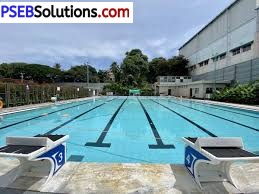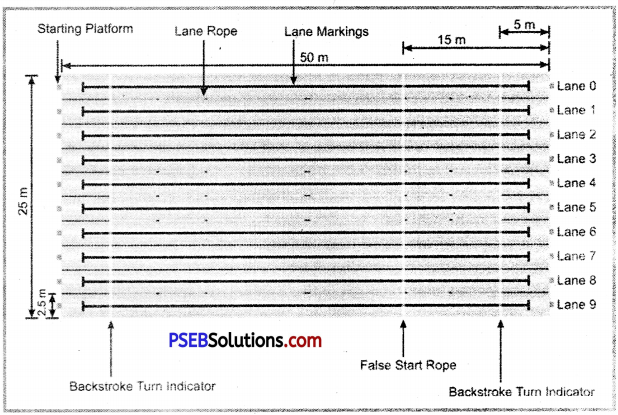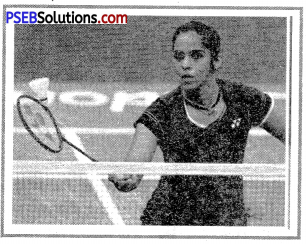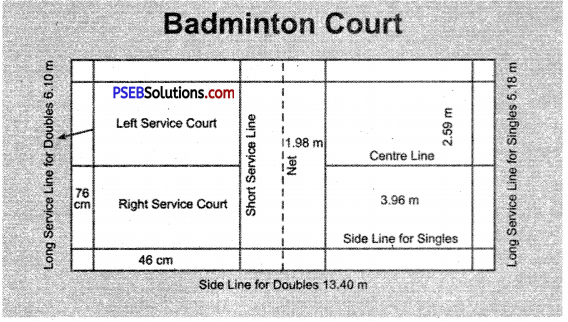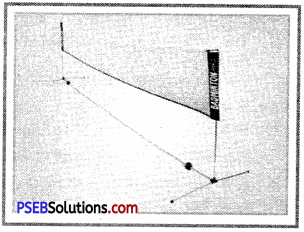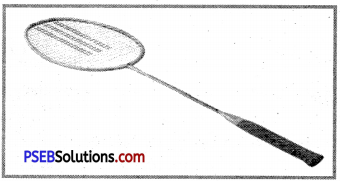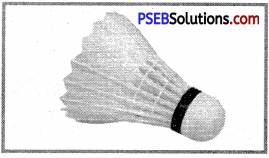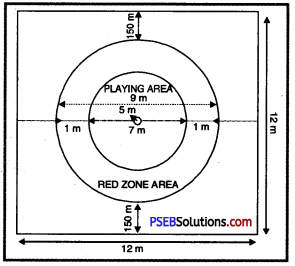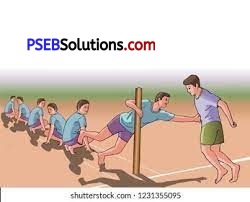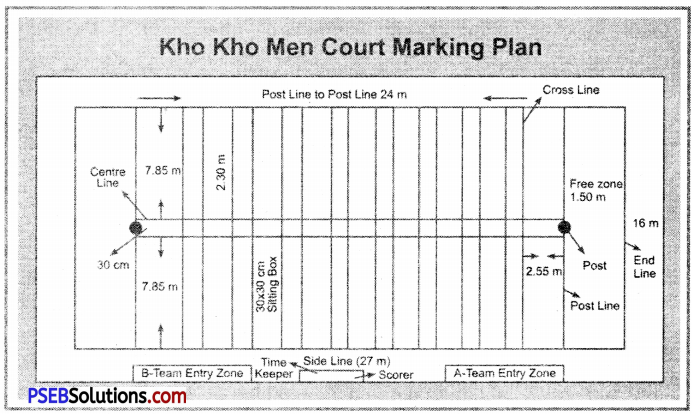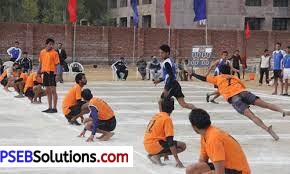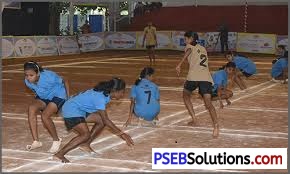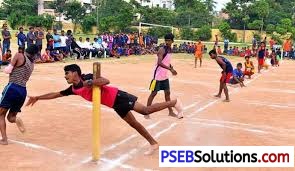Punjab State Board PSEB 12th Class History Book Solutions Chapter 1 पंजाब की भौतिक विशेषताएँ तथा उनका इसके इतिहास पर प्रभाव Textbook Exercise Questions and Answers.
PSEB Solutions for Class 12 History Chapter 1 पंजाब की भौतिक विशेषताएँ तथा उनका इसके इतिहास पर प्रभाव
निबंधात्मक प्रश्न (Essay Type Questions)
पंजाब की भौतिक विशेषताएँ (Physical Features of the Punjab)
प्रश्न 1.
पंजाब की भौगोलिक विशेषताओं का वर्णन करें।
(Describe the Geographical features of Punjab.)
अथवा
पंजाब की भौतिक विशेषताओं का वर्णन कीजिए। (Explain the physical features of Punjab.)] .
अथवा
पंजाब की भौतिक विशेषताओं का विस्तार सहित वर्णन करें। (Describe in detail the physical features of Punjab.)
अथवा
भौतिक विशेषता के आधार पर पंजाब को कितने भागों में विभाजित किया जा सकता है ? किसी एक भाग का विस्तृत वर्णन करें।
(In how many parts can Punjab be divided on the basis of physical features ? Describe any one part in detail.)
उत्तर-
पंजाब फ़ारसी भाषा के दो शब्दों ‘पंज’ और ‘आब’ से मिलकर बना है। पंजाब का अर्थ है पाँच नदियों का प्रदेश। ये पाँच नदियाँ हैं-सतलुज, ब्यास, रावी, जेहलम और चनाब।
पंजाब को भिन्न-भिन्न युगों में भिन्न-भिन्न नामों से पुकारा जाता रहा है। ऋग्वैदिक काल में पंजाब को ‘सप्त सिंधु’ कहा जाता था। महाकाव्यों व पुराणों में पंजाब को पंचनद कहा गया है। यूनानियों ने पंजाब पर अधिकार करने के पश्चात् इसका नाम पैंटापोटामिया रखा। पंजाब में कई शताब्दियों तक टक कबीले का शासन रहा था जिस कारण पंजाब को ‘टक देश’ कहा जाने लगा।
मध्य काल में पंजाब को ‘लाहौर सूबा’ कहा जाने लगा। ऐसा इसे इसकी राजधानी लाहौर के कारण कहा जाने लगा। 1849 ई० में जब अंग्रेजों ने लाहौर राज्य को ब्रिटिश साम्राज्य में शामिल किया तो उन्होंने इसका नाम ‘पंजाब प्रांत’ रखा।
प्रसिद्ध इतिहासकार एस० एम० लतीफ का यह कथन पूर्णत: सही है,
“पूर्व के किसी देश की प्राकृतिक विशेषताओं में इतनी भिन्नता नहीं मिलती जितनी की पाँच नदियों की इस भूमि में मिलती है।”1
भौतिक विशेषताओं के आधार पर हम पंजाब को निम्नलिखित तीन भागों में विभाजित कर सकते हैं—
- हिमालय और सुलेमान पर्वत
- अर्द्ध-पर्वतीय प्रदेश
- मैदानी प्रदेश।
हिमालय और सुलेमान पर्वतीय श्रेणियाँ (The Himalayas and Sulaiman Mountain Ranges)
1. हिमालय पर्वत (The Himalayas) हिमालय पर्वत पंजाब के उत्तर में स्थित है। यह पर्वत पूर्व में असम से लेकर पश्चिम में अफ़गानिस्तान तक फैला हुआ है। इसकी लंबाई 2500 किलोमीटर तथा चौड़ाई 240 किलोमीटर से 320 किलोमीटर है। ऊँचाई के आधार पर हिमालय पर्वत को तीन भागों-उच्च हिमालय, मध्य हिमालय तथा शिवालिक की पहाड़ियों में विभाजित किया जा सकता है।
हिमालय पर्वत पंजाब के लिए उसी प्रकार एक वरदान सिद्ध हुआ है जैसे नील नदी मिस्र के लिए। पंजाब को इससे कई लाभ प्राप्त हुए। प्रथम, यह पंजाब तथा भारतवर्ष का पहरेदार रहा क्योंकि हिमालय पर्वत की ऊँचाई बहुत अधिक है। फलस्वरूप पंजाब उत्तर की ओर से दीर्घकाल तक आक्रमणकारियों से सुरक्षित रहा। दूसरा, मानसून पवनें इससे टकरा कर पंजाब में पर्याप्त वर्षा करती हैं। तीसरा, यहाँ से निकलने वाली नदियों ने पंजाब की भूमि को बहुत उपजाऊ बनाया है। चौथा, हिमालय की वादियों ने पंजाब को शिमला, मनाली, कुल्लू, काँगड़ा, डलहौज़ी तथा कसौली जैसे नगर दिए।
2. सुलेमान पर्वतीय श्रेणियाँ (Sulaiman Mountain Ranges)-सुलेमान पर्वतीय श्रेणियाँ पंजाब के उत्तर-पश्चिम में स्थित हैं। इन श्रेणियों में अनेक दर्रे स्थित हैं जो भारत को एशिया के अन्य देशों से मिलाते हैं। इनमें खैबर, बोलान, कुर्रम, टोची तथा गोमल नामक दर्रे प्रसिद्ध हैं। पंजाब में आने वाले अधिकाँश आक्रमणकारी तथा व्यापारी इन्हीं दरौं द्वारा ही आए।
अर्द्ध-पर्वतीय प्रदेश (Sub-Mountainous Region)
यह प्रदेश शिवालिक पहाड़ियों और पंजाब के मैदानी भाग के मध्य स्थित है। इस प्रदेश को तराई प्रदेश भी कहा जाता है। इस प्रदेश में होशियारपुर, काँगड़ा, अंबाला, गुरदासपुर के उत्तरी क्षेत्र तथा स्यालकोट के कुछ क्षेत्र शामिल हैं। पर्वतीय प्रदेश होने के कारण यहाँ की भूमि कम उपजाऊ है तथा जनसंख्या अधिक सघन नहीं है।
1. “No country in the East presents the same variety of features as does the land of five rivers.” S.M. Latif, History of the Punjab (New Delhi : 1964) p. 12.
मैदानी प्रदेश
(The Plains)
मैदानी प्रदेश पंजाब का सबसे बड़ा और महत्त्वपूर्ण खंड है। यह प्रदेश सिंध और यमुना नदियों के मध्य स्थित है। इस मैदान की गणना विश्व के सबसे उपजाऊ मैदानों में की जाती है। पंजाब में बहने वाले पाँचों दरियासतलुज, ब्यास, रावी, चनाब तथा जेहलम इसी प्रदेश में बहते हैं। यह प्रदेश तीन भागों-पाँच दोआब, मालवा एवं बांगर तथा दक्षिण-पश्चिम के रेगिस्तान में बँटा हुआ है।
1. पाँच दोआब (Five Doabs)—पंजाब के मैदानी प्रदेश का अधिकाँश भाग पाँच दोआबों से घिरा हुआ है। दोआब फ़ारसी भाषा का शब्द है जिसका अर्थ है-दो पानी अथवा दो नदियों के बीच का क्षेत्र। इन दोआबों का वर्णन निम्नलिखित अनुसार है
i) बिस्त जालंधर दोआब (Bist Jalandhar Doab)-ब्यास और सतलुज नदियों के मध्यवर्ती प्रदेश को बिस्त जालंधर दोआब कहते हैं। जालंधर और होशियारपुर इस दोआब के दो सबसे बड़े शहर हैं।
ii) बारी दोआब (Bari Doab)—यह दोआब ब्यास और रावी नदियों के मध्यवर्ती क्षेत्र में स्थित है। बारी दोआब को माझा भी कहा जाता है तथा यहाँ के निवासी मझैल कहलाते हैं। लाहौर तथा अमृतसर इस दोआब में स्थित दो प्रसिद्ध शहर हैं।
iii) रचना दोआब (Rachna Doab)-रावी और चनाब नदियों के मध्यवर्ती क्षेत्र को रचना दोआब कहा जाता है। गुजराँवाला और शेखूपुरा इस दोआब के सबसे प्रसिद्ध शहर हैं।
iv) चज दोआब (Chaj-Doab)—चनाब और जेहलम नदियों के मध्यवर्ती क्षेत्र को चज दोआब कहा जाता है। गुजरात और शाहपुर इस दोआब के प्रसिद्ध शहर हैं।
v) सिंध सागर दोआब (Sindh Sagar Doab)-सिंध और जेहलम नदियों के मध्यवर्ती क्षेत्र को सिंध सागर दोआब कहते हैं। रावलपिंडी इस दोआब का सबसे प्रसिद्ध शहर है।
2. मालवा तथा बांगर (Malwa and Bangar)—पाँच दोआबों के अतिरिक्त पंजाब के मैदानी भाग में सतलुज और यमुना नदियों के बीच में स्थित विस्तृत मैदानी भाग आता है। इसे मालवा और बांगर में विभाजित किया जा सकता है।
i) मालवा (Malwa)-सतलुज और घग्घर नदियों के मध्यवर्ती क्षेत्र को मालवा कहा जाता है। इसमें पटियाला, लुधियाना, मालेरकोटला, भटिंडा, फरीदकोट और नाभा शामिल हैं। यहाँ के निवासियों को ‘मलवई’ कहा जाता है।
ii) बांगर (Bangar) घग्घर एवं यमुना नदियों के मध्य स्थित प्रदेश को बांगर कहा जाता है। इसे हरियाणा भी कहा जाता है। इस प्रदेश में अंबाला, पानीपत, रोहतक, करनाल, कुरुक्षेत्र, गुरु ग्राम (गुड़गाँव) और हिसार के क्षेत्र शामिल हैं।
3. दक्षिण-पश्चिम के रेगिस्तान (South-West Deserts)-पंजाब के दक्षिण-पश्चिम में सिंध, बहावलपुर एवं मुलतान के प्रदेश स्थित हैं। यह संपूर्ण प्रदेश रेगिस्तान है। इस कारण यहाँ की भूमि उपजाऊ नहीं है। अतः इस प्रदेश में मैदानी भागों की अपेक्षा जनसंख्या भी बहुत कम है।
पंजाब की जलवायु
(Climate of the Punjab)
पंजाब की जलवायु में भी बहुत भिन्नता पाई जाती है। यहाँ शीतकाल में भयंकर सर्दी पड़ती है और ग्रीष्मकाल में भयंकर गर्मी पड़ती है। जनवरी और फरवरी के महीनों में यहाँ भयंकर ठंड पड़ती है। मई और जून के महीनों में मैदानी भागों में लुएँ चलती हैं। जुलाई से लेकर सितंबर के महीनों में पंजाब में वर्षा होती है। अक्तूबर-नवंबर और फरवरी-मार्च के महीनों में पंजाब का मौसम बहुत सुहावना होता है।

भौतिक विशेषताओं का पंजाब के इतिहास पर प्रभाव (Influence of Physical Features on the History of Punjab)
प्रश्न 2.
पंजाब के भूगोल ने इसके इतिहास को कैसे प्रभावित किया है ?
(How did the geography of the Punjab affected its history ?)
अथवा
पंजाब के पर्वतों, मैदानों तथा नदियों ने इसके इतिहास को किस प्रकार प्रभावित किया है ?
(How have the mountains, plains and rivers of the Punjab influenced the course of its history ?)
अथवा
पंजाब की भौतिक विशेषताओं ने यहाँ के इतिहास को किस प्रकार प्रभावित किया ?
(How did the physical features of Punjab affected its history ?)
अथवा
पंजाब की भौगोलिक विशेषताओं ने यहाँ के राजनीतिक, सामाजिक, धार्मिक तथा आर्थिक इतिहास को किस प्रकार प्रभावित किया है ?
(How did the geographical features of the Punjab influence its political, social, religious and economic history ?)
अथवा
पंजाब की भौतिक विशेषताओं ने इसके सामाजिक, राजनीतिक और आर्थिक इतिहास को कैसे प्रभावित किया ?
(How did physical features of Punjab influence its social, political and economic history ?)
अथवा
पंजाब की भौगोलिक विशेषताओं के सामाजिक तथा आर्थिक प्रभावों का वर्णन करो।
(Explain the social and economic effects of the geographical features of Punjab.)
अथवा
पंजाब की भौगोलिक विशेषताओं के राजनीतिक, सैनिक और सामाजिक प्रभाव क्या पड़े ?
(What were the political, military and social effects of the geographical features of the Punjab ?)
उत्तर-
किसी भी देश का इतिहास वहाँ के भूगोल से अत्यधिक प्रभावित होता है। अतः पंजाब के इतिहास पर यहाँ की भौगोलिक विशेषताओं का प्रभाव पड़ना स्वाभाविक ही था। जहाँ एक ओर यहाँ के उपजाऊ मैदानों ने विदेशी आक्रमणकारियों को न्यौता दिया एवं नदियों ने उन्हें मार्गदर्शन दिया वहीं दूसरी ओर वनों ने मुग़लों तथा अफ़गानों के अत्याचारों से पीड़ित लोगों को अपने आँचल में आश्रय दिया। पंजाब की भौतिक विशेषताओं का इसके राजनीतिक, सामाजिक, सांस्कृतिक, धार्मिक तथा आर्थिक जीवन पर प्रभाव अग्रलिखित अनुसार है—
I. राजनीतिक प्रभाव (Political Effects)
1.पंजाब-भारत का प्रवेश द्वार (Punjab-Gateway of India)—पंजाब के उत्तर-पश्चिम में खैबर, कर्रम, बोलान, टोची और गोमल नामक प्रसिद्ध दर्रे स्थित थे। इन्हें पार करना कोई मुश्किल काम न था। परिणामस्वरूप विदेशी आक्रमणकारी यहीं से भारत में प्रवेश करते थे। उदाहरण के लिए आर्यों, यूनानियों, कुषाणों, हूणों, तुर्कों, दुर्रानियों तथा मुग़लों ने यहीं से भारत में प्रवेश किया। परिणामस्वरूप पंजाब इन लोगों के लिए एक प्रवेश द्वार का काम करने लगा। इन आक्रमणकारियों का प्रथम संघर्ष पंजाब के लोगों के साथ ही होता था। पंजाब को विजित कर लेने के उपरांत शेष भारत को विजित करना कोई अधिक मुश्किल कार्य न रह जाता था। अत: पंजाब की विजय भारत विजय के समान थी।
2. पंजाब-निर्णायक लड़ाइयों का क्षेत्र (Punjab-the battlefield of Decisive Battles)-पंजाब अपनी भौगोलिक स्थिति के कारण शताब्दियों तक भारतीय इतिहास की अनेक महत्त्वपूर्ण और निर्णायक लड़ाइयों का क्षेत्र रहा है। आर्यों का द्रविड़ लोगों के साथ युद्ध, सिकंदर का पोरस से युद्ध, चंद्रगुप्त का यूनानियों से युद्ध, मुहम्मद गौरी का पृथ्वीराज चौहान के साथ युद्ध तथा पानीपत के तीनों युद्ध पंजाब की धरती पर ही हुए। मुहम्मद गौरी ने जहाँ 1192 ई० में तराइन युद्ध में पृथ्वीराज को हराकर भारत में मुस्लिम राज्य की नींव डाली, वहीं 1526 ई० में पानीपत के प्रथम युद्ध में बाबर ने इब्राहिम लोधी को पराजित कर मुग़ल वंश की स्थापना की।
3. उत्तर-पश्चिमी सीमा की समस्या (North-West Frontier Problem)-पंजाब की उत्तर-पश्चिमी सीमा सदैव यहाँ के शासकों के लिए परेशानी का एक स्रोत रही है। इसके दो प्रमुख कारण थे। पहला, यह कि अधिकतर विदेशी हमलावर इसी रास्ते से भारत आते थे तथा दूसरा, इस सीमा में रहने वाले लोग अत्यंत खूखार थे। वे नित नई परेशानियाँ खड़ी करने से बाज़ नहीं आते थे। अतः प्रत्येक शासक को अपना राज्य बचाने के लिए इस सीमा की सुरक्षा के लिए एक अलग नीति अपनानी पड़ती और अपार धन राशि खर्च करनी पड़ती थी। बलबन, अलाऊद्दीन ख़लजी, अकबर तथा महाराजा रणजीत सिंह ने इस सीमा की ओर विशेष ध्यान दिया। जिन राजाओं ने इस प्रति ध्यान न दिया, उन्हें इसके परिणाम भुगतने पड़े।
4. पंजाबियों को शताब्दियों तक कष्ट झेलने पड़े (Punjabis had to suffer for centuries)—अपनी भौगोलिक स्थिति के कारण पंजाब के निवासियों को शताब्दियों तक कष्ट सहने पड़े। लगभग सभी विदेशी आक्रमणकारी अत्याचारों का सामना सबसे पहले तथा सबसे अधिक पंजाबियों को ही करना पड़ा। महमूद गज़नवी, मुहम्मद गौरी, तैमूर, नादिरशाह तथा अहमदशाह अब्दाली आदि आक्रमणकारियों ने यहाँ के लोगों पर घोर अत्याचार किये। पुरुषों की हत्याएँ कर दी जाती थीं तथा स्त्रियों के साथ दुर्व्यवहार किया जाता था। तलवार की नोक पर बलपूर्वक लोगों को इस्लाम धर्म में शामिल होने के लिए विवश किया जाता था।
5. पंजाब की नदियों का प्रभाव (Influence of the Rivers of the Punjab)-पंजाब का इतिहास यहाँ पर बहने वाली नदियों से भी बहुत प्रभावित हुआ है। इन नदियों ने कभी तो विदेशी आक्रमणकारियों के बढ़ते कदमों को रोका तो कभी उनका मार्ग निर्धारित किया। आक्रमणकारी इन नदियों को वहाँ से पार करते जहाँ से ये कम तंग होती थीं। इस प्रकार पंजाब का भाग्य लिखने में इन नदियों ने महत्त्वपूर्ण भूमिका निभाई।
6. पंजाब के वनों और पर्वतों का प्रभाव (Influence of the Forests and Hills of the Punjab)पंजाब के वनों तथा पर्वतों ने भी पंजाब के राजनीतिक जीवन पर गहरा प्रभाव डाला। जब सिखों पर विदेशी आक्रमणकारियों के अत्याचार बहुत बढ़ गए तो उन्होंने इन्हीं वनों तथा पर्वतों में जाकर शरण ली। इसके साथ ही वे अपने शत्रुओं पर अचानक आक्रमण कर फिर से इन वनों और पर्वतों में जा छुपते थे।
II. सामाजिक तथा सांस्कृतिक प्रभाव
(Social and Cultural Effects)
1. पंजाबियों के चरित्र के विशेष लक्षण (Special traits of the Character of Punjabis)-पंजाब की भौगोलिक स्थिति ने पंजाबियों के चरित्र में विशेष लक्षण पैदा कर दिए। पंजाब के लोग लंबे समय तक विदेशी आक्रमणकारियों से जूझते रहे इसलिए वे शेष भारत के लोगों से अधिक वीर, साहसी तथा कष्टों को सहने वाले बन गए। इसके साथ ही उनमें एक विशेष गुण उत्पन्न हुआ। वह था ‘खाओ, पिओ और मौज़ उड़ाओ’ का। उन्होंने अपना धन स्वादिष्ट भोजन, अच्छे कपड़ों तथा मनोरंजन के साधनों पर खर्च करना आरंभ कर दिया।
2. जातियों तथा उपजातियों की संख्या में वृद्धि (Increase in the number of the Castes and Sub-castes)-अनेकों विदेशी आक्रमणकारियों ने पंजाब की स्त्रियों के साथ विवाह संबंध भी स्थापित किए। परिणामस्वरूप कई नई जातियों तथा उपजातियों का जन्म हुआ। इनमें प्रमुख थीं-पठान, गुज्जर, जाट, स्याल, महाजन तथा डोगरा आदि।
3. पंजाब की विलक्षण संस्कृति (Distinct Culture of the Punjab)—पंजाब में विदेशी आक्रमणकारियों के यहाँ बस जाने के कारण इस धरती पर एक नई विलक्षण संस्कृति का जन्म हुआ। इस संस्कृति में कुछ देशी तथा कुछ विदेशी गुण मौजूद थे।
4. कला तथा साहित्य की क्षति (Loss of the Art and Literature)-पंजाब पर विदेशी आक्रमणकारियों के आक्रमणों के कारण यहाँ सदा अशाँति तथा असुरक्षा का माहौल रहा। परिणामस्वरूप कला और साहित्य के क्षेत्र में पंजाब पिछड़ गया। यदि इस क्षेत्र में थोड़ा बहुत विकास हुआ भी, तो आक्रमणकारियों द्वारा उसे भी नष्ट कर दिया गया।
III. धार्मिक प्रभाव (Religious Effects)
1. हिंदू धर्म का जन्म (Origin of Hinduism)—पंजाब को हिंदू धर्म का जन्म स्थान माना जाता है क्योंकि आर्य लोग सबसे पहले इसी प्रदेश में आकर बसे। उन्होंने अपने पवित्र ग्रंथों की रचना इसी प्रदेश में की। वे अपने ग्रंथों में पंजाब की प्राकृतिक अवस्थाओं का वर्णन करते हैं। विभिन्न हिंदू देवी-देवताओं, पंजाब की नदियों, पर्वतों तथा वनों का उल्लेख इन ग्रंथों में बार-बार आता है।
2. इ.लाम का प्रचार (Propagation of Islam)-पंजाब में भारत के अन्य भागों की तुलना में इस्लाम का अधिक प्रसार हुआ। इसके कई कारण थे। पहला, पंजाब मुस्लिम आक्रमणकारियों के संपर्क में आने वाला प्रथम प्रदेश था। दूसरा, इन आक्रमणकारियों ने यहाँ के निवासियों से तलवार की नोक पर इस्लाम कबूल करवाया। तीसरा, मुसलमान यहाँ पर स्थाई रूप से बसे। चौथा, हिंदू धर्म की बुराइयों ने लोगों को इस्लाम की ओर आकर्षित किया। परिणामस्वरूप, इस्लाम धर्म का पंजाब में तेजी से प्रसार हुआ।
3. सिख धर्म की उत्पत्ति और विकास (Origin and Development of Sikhism) पंजाब की भौगोलिक स्थिति का पंजाब पर पड़ने वाला सबसे महत्त्वपूर्ण धार्मिक प्रभाव था सिख धर्म की उत्पत्ति और उसका विकास। सिख धर्म की स्थापना तथा उसका विकास करने वाले गुरुओं का संबंध पंजाब से ही था। संपन्न पंजाबियों ने भी इस धर्म के प्रसार में भरपूर सहयोग दिया। परिणामस्वरूप, बहुत से लोग सिख धर्म के अनुयायी बन गए।
IV. आर्थिक प्रभाव (Economic Effects)
1. पंजाब का समृद्ध होना (Prosperity of the Punjab)—पंजाब की भौगोलिक विशेषताओं के कारण पंजाब एक समृद्ध प्रदेश बन गया। हिमालय पर्वत से निकलने वाली नदियों ने इसको उपजाऊ मिट्टी प्रदान की। इस पर भरपूर फसलें उपजा कर यहाँ के लोग धनवान् हो गए।
2. कृषि मुख्य व्यवसाय (Agriculture Main Occupation)-पंजाब के लोगों का मुख्य व्यवसाय कृषि है। इसका श्रेय भी यहाँ की भौगोलिक स्थिति को ही जाता है। यहाँ की नदियों द्वारा लाई गई मिट्टी बहुत उपजाऊ है। इस कारण अधिकतर जनसंख्या कृषि का व्यवसाय करती है। यहाँ की मुख्य फसलें हैं-गेहूँ, कपास, चावल, गन्ना, दालें, जौ आदि।
3. विदेशी व्यापार (Foreign Trade)-पंजाब के उत्तर-पश्चिम में स्थित दरों से अगर विदेशी आक्रमणकारी पंजाब आते रहे तो व्यापारी भी इसी रास्ते से आए। पंजाब का विदेशी व्यापार अफ़गानिस्तान और मध्य एशिया के देशों के साथ था। पंजाब से इन देशों को अनाज, चीनी, कपास, ऊनी, सूती और रेशमी वस्त्र आदि का निर्यात किया जाता था तथा इन देशों से घोड़े, सूखे मेवे, दरियाँ, गलीचे, फर आदि का आयात किया जाता था। पंजाब के व्यापारिक नगरों में लाहौर, मुलतान, पेशावर, गुजराँवाला, भटिंडा, अमृतसर आदि प्रमुख थे।
अंत में हम डॉ० बी० एस० निज्जर के इन शब्दों से सहमत हैं,
“पंजाब की भौतिक विशेषताओं ने यहाँ के इतिहास पर बहुत गहरा प्रभाव डाला है।”2

प्रश्न 3.
पंजाब की भौगोलिक विशेषताओं के राजनीतिक प्रभावों का वर्णन करें।
(Explain the political effects of the physical features of Punjab.)
उत्तर-
नोट-इस प्रश्न के उत्तर के लिए विद्यार्थी कृपया प्रश्नु नं० 2 का भाग I देखें।
संक्षिप्त उत्तरों वाले प्रश्न (Short Answer Type Questions)
प्रश्न 1.
पंजाब की भौतिक विशेषताओं का संक्षिप्त वर्णन कीजिए।
(Describe in brief physical features of the Punjab.)
अथवा
पंजाब की कोई तीन भौगोलिक विशेषताएँ लिखो। (Write any three geographical features of the Punjab.)
उत्तर-
पंजाब के उत्तर-पश्चिम में हिमालय पर्वत स्थित है। यह पर्वत बहुत ऊँचा होने के कारण सदियों से पंजाब और भारत के प्रहरी का काम कर रहा है। दूसरा, इस पर्वत से मानसून पवनें टकरा कर पंजाब में वर्षा करती हैं। शिवालिक पहाडियाँ और मैदानी भाग के बीच पंजाब के अर्द्ध-पर्वतीय प्रदेश स्थित हैं। इस प्रदेश को तराई प्रदेश भी कहा जाता है। पहाडी प्रदेश होने के कारण यहाँ की भूमि कम उपजाऊ है। यहाँ पर जनसंख्या अधिक सघन नहीं है। पंजाब का मैदानी प्रदेश सर्वाधिक विख्यात है। इसकी गणना संसार के सबसे उपजाऊ मैदानों में की जाती है।
2. “The effects ofphysical features of the Punjab have exercised a great influence on its history.” Dr. B.S. Nijjar, Punjab Under the Great Mughals (Bombay : 1968) p. 9.
प्रश्न 2.
पंजाब को भारत का प्रवेश द्वार क्यों कहा जाता है ?
(Why is the Punjab called as the Gateway of India ?)
उत्तर-
अपनी भौगोलिक स्थिति के कारण पंजाब शताब्दियों तक भारत का प्रवेश द्वार रहा है। इसके उत्तरपश्चिम की ओर खैबर, कुर्रम, टोची और बोलान नामक दर्रे स्थित हैं। इन दरों को पार करना कोई मुश्किल कार्य नहीं था। प्राचीन काल से विदेशी आक्रमणकारी इसी रास्ते से भारत पर आक्रमण करते रहे। इन आक्रमणकारियों को सर्वप्रथम पंजाब के लोगों से ही संघर्ष करना पड़ा। पंजाब पर विजय प्राप्त करने के पश्चात् ही वे आगे कदम बढ़ा पाए। इसी कारण पंजाब को भारत का प्रवेश द्वारा कहा जाता है।
प्रश्न 3.
पंजाब का भारतीय इतिहास में क्या महत्त्व है ?
(What is the importance of Punjab in the Indian History ?)
उत्तर-
पंजाब का भारतीय इतिहास में कई कारणों से विशेष महत्त्व रहा है। आर्यों ने अपने सुविख्यात धार्मिक ग्रंथ ऋग्वेद की रचना इसी पवित्र भूमि पर की। महाभारत का युद्ध भी इसी भूमि पर हुआ था और श्रीकृष्ण ने गीता का संदेश भी यहीं पर दिया था। इसी भूमि पर चंद्रगुप्त मौर्य ने भारत का प्रथम साम्राज्य स्थापित किया। भारतीय इतिहास की सबसे महत्त्वपूर्ण और निर्णायक लड़ाइयाँ भी यहीं हुईं। इसी पावन भूमि पर सिख धर्म के नौ गुरुओं ने अवतार लिया। सिखों के दसवें गुरु, गुरु गोबिंद सिंह जी ने अपना अधिकाँश समय यहीं व्यतीत किया।

प्रश्न 4.
हिमालय पर्वत के पंजाब को क्या मुख्य लाभ हुए ? (What were the main benefits of the Himalayas to Punjab ?)
अथवा
” हिमालय से पंजाब को होने वाले कोई तीन लाभ बताएँ।
उत्तर-
- हिमालय पर्वत सदियों से एक प्रहरी का कार्य दे कर है।
- हिमालय की पहाड़ियों ने शिमला, मनाली, कुल्लू, डलहौज़ी जैसे सुंदर नगर दिए।
- हिमालय ने पंजाब की आर्थिक समृद्धि में बहुमूल्य योगदान दिया।
प्रश्न 5.
दोआब शब्द से क्या अभिप्राय है ? पंजाब के पाँच दोआबों का संक्षिप्त विवरण दो।
(What do you mean by Doab ? Give a brief description of five Doabs of Punjab.)
अथवा
पंजाब के तीन दोआबों का वर्णन करें। (Explain the three Doabs of Punjab.)
उत्तर-
दोआब फ़ारसी भाषा का शब्द है जिससे अभिप्राय है दो नदियों के बीच का क्षेत्र । ब्यास और सतलुज नदियों के मध्यवर्ती प्रदेश को बिस्त जालंधर दोआब कहते हैं। ब्यास और रावी नदियों के मध्यवर्ती प्रदेश को बारी दोआब कहते हैं। रावी और चिनाब नदियों के मध्यवर्ती प्रदेश को रचना दोआब कहते हैं। चिनाब और जेहलम के मध्यवर्ती प्रदेश को चज दोआब कहते हैं। सिंध और जेहलम नदियों के मध्यवर्ती प्रदेश को सिंध सागर दोआब कहते हैं।
प्रश्न 6.
पंजाब के मैदानी भागों का संक्षेप में वर्णन करें।
(Describe briefly about plain areas of Punjab.)
उत्तर-
मैदानी प्रदेश पंजाब का सबसे बड़ा और महत्त्वपूर्ण खंड है। सही अर्थों में यही पंजाब है। यह प्रदेश सिंध और यमुना नदियों के मध्य स्थित है। इस मैदान की गणना विश्व के सबसे उपजाऊ मैदानों में की जाती है। इसकी समुद्र तल से औसत ऊँचाई 1000 फुट से अधिक नहीं है। पंजाब में बहने वाले पाँचों दरिया-सतलुज, ब्यास, रावी, चिनाब, जेहलम इसी प्रदेश में बहते हैं। क्योंकि यह प्रदेश बहुत उपजाऊ है, वर्षा पर्याप्त होती है और यातायात के साधन विकसित हैं, इसलिए यहाँ की जनसंख्या भी काफ़ी सघन है। मैदानी प्रदेश को तीन भागों में विभाजित किया जा सकता है—
- पाँच दोआब
- मालवा और बांगर
- दक्षिण-पश्चिम के रेगिस्तान।

प्रश्न 7.
मालवा तथा बांगर से आपका क्या भाव है ? (What do you understand by Malwa and Bangar ?)
उत्तर-
1. मालवा-सतलुज और घग्गर नदियों के मध्यवर्ती क्षेत्रों को मालवा कहा जाता है। इसमें पटियाला, लुधियाना, सरहिंद, संगरूर, मालेरकोटला, भटिंडा, फरीदकोट और नाभा शामिल हैं। इस प्रदेश में ‘मलव’ नामक प्रसिद्ध कबीला रहता था जिस कारण इस प्रदेश का नाम मालवा पड़ गया। यहाँ के निवासियों को ‘मलवई’ पुकारा जाता है।
2. बांगर-घग्गर एवं यमुना नदियों के मध्य स्थित प्रदेशों को बांगर कहा जाता है। इसे हरियाणा भी कहा जाता है। इस प्रदेश में अंबाला, पानीपत, रोहतक, करनाल, कुरुक्षेत्र, गुरु ग्राम (गुड़गाँव), जींद और हिसार के क्षेत्र शामिल हैं। पंजाब के इस भाग में भारतीय इतिहास की कई निर्णायक लड़ाइयाँ हुईं।
प्रश्न 8.
पंजाब की भौतिक विशेषताओं ने यहाँ के राजनीतिक इतिहास पर क्या प्रभाव डाला ? (What influence did the physical features of the Punjab have on its political History ?)
अथवा
पंजाब की भौगोलिक विशेषताओं के क्या राजनीतिक प्रभाव पड़े ?
(What were the political effects of the geographical features of the Punjab ?)
अथवा
पंजाब की भौगोलिक विशेषताओं के कोई तीन राजनीतिक प्रभाव लिखें। (Write any three political effects of the geographical features of the Punjab.)
उत्तर-
- पंजाब अपनी भौगोलिक स्थिति के कारण शताब्दियों तक भारत का प्रवेश द्वार रहा है।
- अपनी भौगोलिक स्थिति के कारण पंजाब के लाहौर, मुलतान, पेशावर, तथा सरहिंद नामक नगरों का विशेष महत्त्व रहा है।
- पंजाब में बहने वाले दरियाओं ने यहाँ के इतिहास को प्रभावित किया है।
- पंजाब के जंगलों और पर्वतों ने भी पंजाब के इतिहास पर गहरा प्रभाव डाला है।
प्रश्न 9.
पंजाब की भौतिक विशेषताओं ने इसके आर्थिक इतिहास पर क्या प्रभाव डाला है ? (What impact did the physical features of the Punjab have on its economic History ?)
अथवा
पंजाब के भूगोल पर पड़े तीन मुख्य आर्थिक प्रभावों का वर्णन करो। (Write three economic influences on the Geography of Punjab.)
अथवा
पंजाब के भूगोल ने यहाँ के आर्थिक जीवन को कैसे प्रभावित किया ? (How did the geography of the Punjab affect its economic life ?)
उत्तर-
- पंजाब का मैदानी भाग बहुत उपजाऊ होने के कारण यहाँ के लोगों का मुख्य व्यवसाय कृषि था।
- पंजाब के पहाड़ी क्षेत्रों में लोग भेड़-बकरियाँ पालते थे।
- अपनी भौगोलिक स्थिति के कारण पंजाब के लाहौर, मुलतान, सरहिंद, जालंधर, अमृतसर तथा समाना प्रसिद्ध व्यापारिक नगर बन गए थे।
- पंजाब की भौगोलिक स्थिति के कारण ही यहाँ का विदेशी व्यापार बड़ा विकसित रहा था।

प्रश्न 10.
पंजाब की नदियों ने यहाँ के इतिहास को कैसे प्रभावित किया ? (How did the rivers of the Punjab influence its History ?) :
अथवा
पंजाब की नदियों ने यहाँ के इतिहास पर क्या प्रभाव डाला ?
(What are the effects of Punjab rivers on the History of the Punjab ?) .
उत्तर-
पंजाब के इतिहास को यहाँ बहने वाली नदियों ने बहुत प्रभावित किया है। इन नदियों के कारण ही विदेशी आक्रमणकारी अपने कदम आगे नहीं बढ़ा पाए और देश की रक्षा होती रही। जब इन नदियों में बाढ़ आई होती थी तो उन्हें पार करना बहुत कठिन होता था। इन नदियों ने अनेक बार आक्रमणकारियों का मार्ग भी निर्धारित किया। इन नदियों के कारण पंजाब की भूमि बहुत उपजाऊ बनी। परिणामस्वरूप पंजाब के लोग आर्थिक पक्ष से बहुत समृद्ध हुए।
प्रश्न 11.
पंजाब के वनों और पर्वतों ने यहाँ के इतिहास पर गहरा प्रभाव डाला है। क्या आप इस कथन से सहमत हैं ?
(The forests and hills of the Punjab have deeply ipfluenced its History. Do you agree with this statement ?)
अथवा
पंजाब के जंगलों और पहाड़ों ने इसके इतिहास पर क्या प्रभाव डाला ? (How did the forests and hills of Punjab affect its History ?)
अथवा
पंजाब के जंगलों ने इसके इतिहास को कैसे प्रभावित किया ? (How did the forests of Punjab affect its History ?)
उत्तर-
पंजाब के इतिहास पर पंजाब के वनों और पर्वतों ने भी गहरा प्रभाव डाला है। 1716 ई० में बंदा सिंह बहादुर के बलिदान के पश्चात् सिखों पर मुग़लों तथा अफ़गानों के अत्याचार जब बहुत बढ़ गए तो इन वनों और पर्वतों ने ही उन्हें शरण दी। यहाँ से उन्होंने गुरिल्ला (छापामार) युद्ध प्रणाली अपना कर शत्रुओं का सामना किया। . वे शत्रुओं की सेना पर अचानक आक्रमण करके पुनः इन वनों और पर्वतों में जा छुपते थे। सिखों ने गुरिल्ला युद्ध नीति अपना कर नादिरशाह एवं अहमद शाह अब्दाली को लूट लिया था।
प्रश्न 12.
पंजाब की भौतिक विशेषताओं ने इसके सामाजिक-सांस्कृतिक इतिहास पर क्या प्रभाव डाला है ? (What effect did the physical features of Punjab have on its socio-cultural History ?)
अथवा
पंजाब की भौगोलिक विशेषताओं के सामाजिक तथा सांस्कृतिक प्रभावों का उल्लेख कीजिए।
(Mention the socio-cultural effects of the geographical features of the Punjab.)
उत्तर-
प्राचीन काल से बहुत-से आक्रमणकारी. पंजाब में ही बस गए। उन्होंने यहाँ की महिलाओं के साथ विवाह कर लिए। परिणामस्वरूप पंजाब में कई नई जातियाँ तथा उपजातियाँ अस्तित्व में आईं। पंजाब में विभिन्न देशों तथा धर्मों के लोगों के बसने के कारण एक नई संस्कृति का जन्म हुआ। पंजाब की भौगोलिक स्थिति के कारण पंजाब के लोग बहुत बहादुर बन गए। विदेशियों के लगातार आक्रमणों के कारण पंजाब के साहित्य एवं कला को भारी धक्का लगा।

प्रश्न 13.
पंजाब की भौगोलिक स्थिति ने यहाँ के धार्मिक जीवन को किस प्रकार प्रभावित किया ?
(How did geography of the Punjab affect its religious life ?)
अथवा
“पंजाब धार्मिक आंदोलनों की भूमि है।” इस कथन की व्याख्या करें। (“Punjab was a land of religious movements.” Explain this statement.)
उत्तर-
पंजाब की भौगोलिक स्थिति ने यहाँ के लोगों के धार्मिक जीवन को भी काफ़ी प्रभावित किया। पंजाब को हिंदू धर्म की जन्म भूमि कहा जाता है। आर्य सर्वप्रथम इसी प्रदेश में आकर बसे थे। यहाँ ही उन्होंने अपने अधिकतर धार्मिक साहित्य की रचना की। पंजाब में भारत के अन्य भागों की अपेक्षा इस्लाम का अधिक प्रचार हुआ। पंजाब में सिख धर्म के संस्थापक गुरु नानक देव जी एवं उनके आठ उत्तराधिकारियों ने अवतार धारण किया था। गुरु गोबिंद सिंह जी के जीवन का अधिकाँश समय यहीं पर व्यतीत हुआ था। इस प्रकार हम देखते हैं कि पंजाब की भूमि ने विभिन्न धर्मों का पालन-पोषण किया।
प्रश्न 14.
पंजाब की भौतिक विशेषताओं ने यहाँ के इतिहास पर बहुत गहरा प्रभाव डाला। किन्हीं तीन महत्त्वपूर्ण प्रभावों का संक्षिप्त वर्णन करें।
(Physical features of the Punjab greatly influenced its History. Write briefly three important effects.) .
उत्तर-
- पंजाब अपनी भौगोलिक स्थिति के कारण शताब्दियों तक भारत का प्रवेश द्वार रहा है।
- उत्तर-पश्चिम में स्थित दरों द्वारा विदेशी आक्रमणकारी से भारत पर आक्रमण करते रहे हैं।
- पंजाब की इस पवित्र धरती पर सिख धर्म ने जन्म लिया।
- क्योंकि पंजाब शताब्दियों से युद्ध स्थल बना रहा, इसीलिए यहाँ कला तथा साहित्य का विकास नहीं हो सका।
- प्राचीन काल से ही पंजाब अपनी भौगोलिक स्थिति के कारण आर्थिक पक्ष से बड़ा समृद्ध रहा है।
वस्तुनिष्ठ प्रश्न (Objective Type Questions)
(i) एक शब्द से एक पंक्ति तक के उत्तर (Answer in One Word to One Sentence)
प्रश्न 1.
पंजाब शब्द से क्या अभिप्राय है?
उत्तर-
पाँच दरियाओं (नदियों) की धरती।

प्रश्न 2.
पंजाब का नाम पंजाब क्यों पड़ा?
उत्तर-
क्योंकि यहाँ पाँच दरिया बहते थे।
प्रश्न 3.
पंजाब की किसी एक नदी का नाम लिखो।
उत्तर-
सतलुज।
प्रश्न 4.
ऋग्वैदिक काल में पंजाब को किस नाम से जाना जाता था?
अथवा
ऋग्वैदिक काल में पंजाब का क्या नाम था ?
उत्तर-
सप्त सिंधु।

प्रश्न 5.
सप्त सिंधु से क्या अभिप्राय है ?
उत्तर-
सात दरिया।
प्रश्न 6.
यूनानियों ने पंजाब को क्या नाम दिया ?
उत्तर-
पैंटापोटामिया।
प्रश्न 7.
पैंटापोटामिया से क्या अभिप्राय है ?
उत्तर-
पाँच दरिया।

प्रश्न 8.
महाकाव्यों तथा पुराणों में पंजाब को क्या कहा जाता था?
उत्तर-
पंचनद।
प्रश्न 9.
पंचनद से क्या अभिप्राय है ?
उत्तर-
पाँच नदियाँ। ।
प्रश्न 10.
पंजाब को टक देश क्यों कहा जाता था ?
उत्तर-
क्योंकि यहाँ लंबे समय तक टक कबीले का शासन रहा था।

प्रश्न 11.
मध्यकाल में पंजाब का क्या नाम था ?
अथवा
मध्यकाल में पंजाब को क्या कहा जाता था ?
उत्तर-
लाहौर सूबा।
प्रश्न 12.
महाराजा रणजीत सिंह के समय में पंजाब को क्या कहा जाता था?
उत्तर-
लाहौर राज्य।
प्रश्न 13.
लाहौर राज्य को अंग्रेज़ी साम्राज्य में कब सम्मिलित किया गया?
उत्तर-
29 मार्च, 1849 ई०।

प्रश्न 14.
पंजाब पर अंग्रेज़ों का कब्ज़ा सबसे बाद में क्यों हुआ?
उत्तर-
भौगोलिक स्थिति के कारण।
प्रश्न 15.
1947 ई० में पंजाब का कौन-सा भाग पाकिस्तान को दिया गया?
उत्तर-
पश्चिमी भाग।
प्रश्न 16.
पंजाब के भौगोलिक खंडों के नाम बताएँ।
अथवा
पंजाब के भौतिक लक्षणों के नाम बताएँ।
अथवा
पंजाब को भौगोलिक दृष्टि से किन तीन खंडों में बाँटा जाता है?
उत्तर-
हिमालय तथा सुलेमान पर्वत श्रेणियाँ, उप-पर्वतीय खंड तथा मैदानी क्षेत्र।

प्रश्न 17.
पंजाब को किस देश की खड़ग भुजा कहा जाता है ?
उत्तर-
भारत की।
प्रश्न 18.
पंजाब को भारत की खड्ग-भुजा क्यों कहा जाता है?
उत्तर-
क्योंकि यहाँ के लोगों ने भारत की सुरक्षा के लिए मुख्य भूमिका अदा की।
प्रश्न 19.
भारत का प्रवेश द्वार किसे कहा जाता था?
उत्तर-
पंजाब।

प्रश्न 20.
पंजाब को भारत का प्रवेश द्वार क्यों कहा जाता है?
उत्तर-
क्योंकि विदेशी आक्रमणकारियों को भारत में प्रवेश करने के लिए सर्वप्रथम पंजाब में प्रवेश करना पड़ता था।
प्रश्न 21.
पंजाब में आने वाले विदेशी आक्रमणकारी किस दिशा से पंजाब में प्रवेश करते रहे हैं?
उत्तर-
उत्तर-पश्चिम दिशा से।
प्रश्न 22.
भारत की उत्तर-पश्चिमी सीमा में स्थित दरों में से सबसे अधिक आक्रमण किस दर्रे से हुए ?
उत्तर-
खैबर।

प्रश्न 23.
पंजाब के उत्तर-पश्चिम में स्थित सबसे प्रसिद्ध दर्रे का नाम बताएँ।
उत्तर-
खैबर।
प्रश्न 24.
हिमालय की सबसे ऊँची चोटी कौन-सी है?
उत्तर-
माऊँट एवरेस्ट।
प्रश्न 25.
हिमालय पर्वत के पंजाब को कौन-सा एक मुख्य लाभ हुआ?
उत्तर-
इसने उत्तर दिशा से विदेशी आक्रमणकारियों से पंजाब की रक्षा की।

प्रश्न 26.
पंजाब के कोई एक सुंदर पर्वतीय नगर का नाम बताएँ जो हिमालय की देन है?
उत्तर-
शिमला।
प्रश्न 27.
तराई अथवा उप-पर्वतीय प्रदेश कहाँ स्थित है?
उत्तर-
हिमालय पर्वत के ऊँचे प्रदेशों तथा पंजाब के मैदानी क्षेत्रों के मध्य।
प्रश्न 28.
दोआब शब्द से क्या अभिप्राय है?
उत्तर-
दो नदियों के बीच का क्षेत्र।

प्रश्न 29.
पंजाब को कितने दोआबों में विभाजित किया गया है?
उत्तर-
पाँच।
प्रश्न 30.
पाँच दुआबे किस मुग़ल बादशाह के समय बनाए गए थे ?
उत्तर-
अकबर।
प्रश्न 31.
किसी एक दोआब का नाम लिखें।
उत्तर-
बिस्त जालंधर दोआब।

प्रश्न 32.
जालंधर किस दोआब में स्थित है?
उत्तर-
बिस्त जालंधर दोआब ।
प्रश्न 33.
होशियारपुर किस दोआब में स्थित है?
उत्तर-
बिस्त जालंधर दोआब ।
प्रश्न 34.
बारी दोआब से क्या अभिप्राय है ?
उत्तर-
ब्यास और रावी नदियों के मध्य स्थित प्रदेश।

प्रश्न 35.
बारी दोआब के किसी एक प्रसिद्ध शहर का नाम बताएँ।
उत्तर-
लाहौर।
प्रश्न 36.
लाहौर किस दोआब में स्थित है ?
उत्तर-
बारी दोआब में।
प्रश्न 37.
बारी दोआब को अन्य किस नाम से जाना जाता है ?
उत्तर-
माझा।

प्रश्न 38.
बारी दोआब को ‘माझा’ क्यों कहा जाता है?
उत्तर-
पंजाब के मध्य में स्थित होने के कारण।
प्रश्न 39.
अमृतसर किस दोआब में स्थित है?
उत्तर-
बारी दोआब।
प्रश्न 40.
मालवा के लोगों को किस नाम से जाना जाता है?
उत्तर-
मलवई।

प्रश्न 41.
मालवा प्रदेश कहाँ स्थित है ?
उत्तर-
सतलुज तथा घग्घर दरियाओं के मध्य।
प्रश्न 42.
मालवा का यह नाम क्यों पड़ा ?
उत्तर-
मल्लव नाम की बहादुर जाति के निवास के कारण।
प्रश्न 43.
मालवा प्रदेश के किसी एक मुख्य नगर का नाम बताएँ।
उत्तर-
पटियाला।

प्रश्न 44.
रचना दोआब से क्या अभिप्राय है?
उत्तर-
रावी एवं चिनाब नदियों के मध्य स्थित प्रदेश।
प्रश्न 45.
रचना दोआब के किसी एक प्रसिद्ध नगर का नाम बताएँ।
उत्तर-
गुजराँवाला।
प्रश्न 46.
चज दोआब से क्या अभिप्राय है ?
उत्तर-
चिनाब और जेहलम नदियों के मध्य स्थित प्रदेश।

प्रश्न 47.
चिनाब और जेहलम नदियों के मध्य के क्षेत्र को क्या कहा जाता है?
उत्तर-
चज दोआब।
प्रश्न 48.
सिंध सागर दोआब कहाँ स्थित है ?
उत्तर-
सिंध तथा जेहलम नदियों के मध्य।
प्रश्न 49.
सिंध सागर दोआब के सबसे प्रसिद्ध नगर का नाम बताएँ।
उत्तर-
रावलपिंडी।

प्रश्न 50.
बांगर प्रदेश कहाँ स्थित है ?
उत्तर-
घग्घर तथा यमुना दरियाओं के मध्य।
प्रश्न 51.
पंजाब की दो प्रसिद्ध फसलों के नाम लिखो।
उत्तर-
गेहूँ और गन्ना।
प्रश्न 52.
तराइन की प्रथम लड़ाई कब हुई ?
उत्तर-
1191 ई०।

प्रश्न 53.
तराइन की द्वितीय लड़ाई कब हुई ?
उत्तर-
1192 ई०।
प्रश्न 54.
पानीपत की प्रथम लड़ाई कब हुई?
उत्तर-
1526 ई०।
प्रश्न 55.
पानीपत की द्वितीय लड़ाई कब हुई ?
उत्तर-
1556 ई०।

प्रश्न 56.
हिमालय द्वारा पंजाब के इतिहास पर डाला कोई एक महत्त्वपूर्ण प्रभाव बताएँ।
उत्तर-
इसने पंजाब की खुशहाली में वृद्धि की है।
प्रश्न 57.
पंजाब की भूमि कैसी है ?
उत्तर-
बहुत उपजाऊ।
प्रश्न 58.
पंजाब के दरियाओं ने इसके इतिहास को कैसे प्रभावित किया है ?
उत्तर-
इनके द्वारा देश की सुरक्षा का कार्य किया गया है।

प्रश्न 59.
पंजाब के पर्वतों तथा जंगलों ने इसके इतिहास को कैसे प्रभावित किया है ?
उत्तर-
इनके द्वारा सिखों की शक्ति के उत्थान में बहुमूल्य योगदान दिया गया है।
प्रश्न 60.
पंजाब के मैदानी भागों ने पंजाब के इतिहास पर क्या प्रभाव डाला?
उत्तर-
पंजाब की आर्थिक समृद्धि कई विदेशी आक्रमणकारियों की प्रेरणा का स्रोत बनी।
प्रश्न 61.
पंजाब की आर्थिक समृद्धि का कोई एक कारण लिखो।
उत्तर-
पंजाब का विदेशों के साथ व्यापार काफ़ी विकसित रहा।

(ii) रिक्त स्थान भरें (Fill in the Blanks)
प्रश्न 1.
पंजाब फ़ारसी भाषा के दो शब्दों……और……..के मेल से बना है।
उत्तर-
(पंज, आब)
प्रश्न 2.
पंजाब से भाव है………दरियाओं का प्रदेश।
उत्तर-
(पाँच)
प्रश्न 3.
पंजाब को भारत का………..कहा जाता है।
उत्तर-
(प्रवेश द्वार)

प्रश्न 4.
ऋग्वैदिक काल में पंजाब को……..कहा जाता था।
उत्तर-
(सप्त-सिंधु)
प्रश्न 5.
यूनानियों ने पंजाब को……….नाम दिया।
उत्तर-
(पैंटापोटामिया)
प्रश्न 6.
पुराणों में पंजाब को………..कहा जाता था।
उत्तर-
(पंचनद)

प्रश्न 7.
मध्यकाल में पंजाब का नाम………..था।
उत्तर-
(लाहौर सूबा)
प्रश्न 8.
महाराजा रणजीत सिंह के समय पंजाब को ………… का नाम दिया गया।
उत्तर-
(लाहौर राज्य)
प्रश्न 9.
आधुनिक पंजाब के……..ज़िले हैं।
उत्तर-
(22)

प्रश्न 10.
हिमालय पर्वत की सबसे ऊंची चोटी का नाम…………है।
उत्तर-
(माऊंट ऐवरेस्ट)
प्रश्न 11.
हिमालय से भाव……..है।
उत्तर-
(बर्फ का घर)
प्रश्न 12.
पंजाब के उत्तर-पश्चिम में सब से प्रसिद्ध……..दर्रा है।
उत्तर-
(खैबर)

प्रश्न 13.
पंजाब में………..दुआब हैं।
उत्तर-
(पाँच)
प्रश्न 14.
दुआब शब्द से भाव…….है।
उत्तर-
(दो दरियाओं के मध्य का क्षेत्र)
प्रश्न 15.
बारी दुआब को…….भी कहा जाता है।
उत्तर-
(माझा)

प्रश्न 16.
रचना दुआब का सबसे प्रसिद्ध शहर……..है।
उत्तर-
(गुजरांवाला)
प्रश्न 17.
…….सिंध सागर दुआब का सब से प्रसिद्ध शहर है।
उत्तर-
(रावलपिंडी)
प्रश्न 18.
मालवा के निवासियों को………कहा जाता है।
उत्तर-
(मलवई)

प्रश्न 19.
……….में तराइन का प्रथम युद्ध हुआ।
उत्तर-
(1191 ई०)
प्रश्न 20.
………..में तराइन का द्वितीय युद्ध हुआ।
उत्तर-
(1192 ई०)
प्रश्न 21.
1556 ई० में अकबर और हेमू के मध्य पानीपत की……….लड़ाई हुई।
उत्तर-
(दूसरी)

प्रश्न 22.
पानीपत की तीसरी लड़ाई………में हुई।
उत्तर-
(1761 ई०)
(ii) ठीक अथवा गलत (True or False)
नोट-निम्नलिखित में से ठीक अथवा गलत चुनें—
प्रश्न 1.
पंजाब शब्द से भाव है पाँच दरियाओं की धरती।
उत्तर-
ठीक
प्रश्न 2.
ऋग्वैदिक काल में पंजाब को सप्त सिंधु कहा जाता था।
उत्तर-
ठीक

प्रश्न 3.
महाकाव्यों और पुराणों में पंजाब को टक देश कहा जाता था।
उत्तर-
गलत
प्रश्न 4.
यूनानियों ने पंजाब का नाम ‘पैंटापोटामिया’ रखा।
उत्तर-
ठीक
प्रश्न 5.
मध्य काल में पंजाब को लाहौर सूबा कहा जाता था।
उत्तर-
ठीक

प्रश्न 6.
महाराजा रणजीत सिंह के समय पंजाब को लाहौर राज्य का नाम दिया गया।
उत्तर-
ठीक
प्रश्न 7.
हिमालय से भाव हैं बर्फ का घर।
उत्तर-
ठीक
प्रश्न 8.
पंजाब के उत्तर-पश्चिम में स्थित सब से प्रसिद्ध दर्रे का नाम गोमल है।
उत्तर-
गलत

प्रश्न 9.
दुआब से अभिप्राय है दो दरियाओं के मध्य का क्षेत्र।
उत्तर-
ठीक
प्रश्न 10.
होशियारपुर बारी दुआब में स्थित है।
उत्तर-
गलत
प्रश्न 11.
बारी दुआब को माझा भी कहा जाता है।
उत्तर-
ठीक

प्रश्न 12.
ब्यास और सतलज दरियाओं के मध्यवर्ती प्रदेश को बिस्त जालंधर दुआब कहा जाता है।
उत्तर-
ठीक
प्रश्न 13.
रावी और चिनाब दरियाओं के मध्यवर्ती प्रदेश को रचना दुआब कहा जाता है।
उत्तर-
ठीक
प्रश्न 14.
रचना दुआब में स्थित सबसे प्रसिद्ध शहर का नाम गुजराँवाला है। .
उत्तर-
ठीक

प्रश्न 15.
सतलुज और चिनाब दरियाओं के मध्यवर्ती प्रदेश को चज दुआब कहा जाता है।
उत्तर-
गलत
प्रश्न 16.
सिंध सागर दुआब का सबसे प्रसिद्ध शहर रावलपिंडी है।
उत्तर-
ठीक
प्रश्न 17.
सतलुज और यमुना नदियों के मध्यवर्ती क्षेत्र को मालवा कहा जाता है।
उत्तर-
गलत

प्रश्न 18.
मालवा के निवासियों को मलवई कहा जाता है।
उत्तर-
ठीक
प्रश्न 19.
घग्घर और यमुना नदियों के मध्यवर्ती क्षेत्र को बांगर कहा जाता है।
उत्तर-
ठीक
प्रश्न 20.
तराइन की दूसरी लड़ाई 1193 ई० में हुई।
उत्तर-
गलत

प्रश्न 21.
बाबर और इब्राहिम लोधी के मध्य पानीपत की पहली लड़ाई 1556 ई० में हुई।
उत्तर-
गलत
प्रश्न 22.
1556 ई० में अकबर और हेमू के मध्य पानीपत की दूसरी लड़ाई हुई।
उत्तर-
ठीक
प्रश्न 23.
पानीपत की तीसरी लड़ाई 1761 ई० में हुई।
उत्तर-
ठीक

प्रश्न 24.
पंजाब में सिख धर्म का जन्म हुआ।
उत्तर-
ठीक
प्रश्न 25.
पंजाब के लोगों का मुख्य व्यवसाय खेती-बाड़ी है।
उत्तर-
ठीक
प्रश्न 26.
पंजाब अपनी भौगोलिक स्थिति के कारण आर्थिक पक्ष से बड़ा खुशहाल रहा है।
उत्तर-
ठीक

(iv) बहु-विकल्पीय प्रश्न (Multiple Choice Questions) :
नोट-निम्नलिखित में से ठीक उत्तर का चयन कीजिए—
प्रश्न 1.
पंजाब शब्द से क्या अभिप्राय है ?
(i) दो नदियों की धरती
(ii) तीन नदियों की धरती
(iii) चार नदियों की धरती
(iv) पाँच नदियों की धरती।
उत्तर-
(iv)
प्रश्न 2.
पंजाब किस भाषा का शब्द है ?
(i) फ़ारसी
(ii) उर्दू
(iii) हिंदी
(iv) गुरमुखी।
उत्तर-
(i)
प्रश्न 3.
ऋग्वैदिक काल में पंजाब को किस नाम से पुकारते थे ?
(i) सप्त सिंधु
(ii) पैंटापोटामिया
(iii) टक देश
(iv) इनमें से कोई नहीं।
उत्तर-
(i)

प्रश्न 4.
यूनानियों ने पंजाब को क्या नाम दिया ?
(i) पंचनद
(ii) सप्त सिंधु
(ii) टक देश
(iv) पैंटापोटामिया।
उत्तर-
(iv)
प्रश्न 5.
प्राचीन काल में पंजाब को टक देश क्यों कहा जाता था ?
(i) टक कबीले के कारण
(ii) टक राजे के कारण
(iii) टक सिक्के के कारण
(iv) टक पहाड़ के कारण।
उत्तर-
(i)
प्रश्न 6.
मध्यकाल में पंजाब की राजधानी का क्या नाम था ?
(i) मुलतान
(ii) रावलपिंडी
(iii) काबुल
(iv) लाहौर।
उत्तर-
(iv)

प्रश्न 7.
पंजाब के उत्तर-पश्चिम में स्थित सबसे प्रसिद्ध दर्रे का नाम बताएँ।
(i) खैबर
(ii) कुर्रम
(iii) टोची
(iv) बोलान। ।
उत्तर-
(i)
प्रश्न 8.
हिमालय पर्वत की सबसे ऊँची चोटी का क्या नाम है ?
(i) कंचन जंगा
(ii) नंदा देवी
(iii) माऊँट एवरेस्ट
(iv) K2.
उत्तर-
(iii)
प्रश्न 9.
हिमालय पर्वत की लंबाई लगभग कितनी है ?
(i) 1200 किलोमीटर
(ii) 1800 किलोमीटर
(iii) 2000 किलोमीटर
(iv) 2500 किलोमीटर।
उत्तर-
(iv)

प्रश्न 10.
दोआब से क्या अभिप्राय है ?
(i) दो नदियों के बीच का क्षेत्र
(ii) दो पर्वतों के बीच का क्षेत्र
(iii) दो मैदानों के बीच का क्षेत्र
(iv) इनमें से कोई नहीं।
उत्तर-
(i)
प्रश्न 11.
पंजाब में कितने दोआब हैं ?
(i) दो
(ii) तीन
(iii) चार
(iv) पाँच।
उत्तर-
(iv)
प्रश्न 12.
अमृतसर निम्नलिखित में से किस दोआब में स्थित है ?
(i) चज दोआब
(ii) बिस्त दोआब
(iii) रचना दोआब
(iv) बारी दोआब।
उत्तर-
(iv)

प्रश्न 13.
रचना दोआब कहाँ स्थित है ?
(i) रावी और चिनाब नदियों के मध्य में
(ii) चनाब और जेहलम नदियों के मध्य में
(iii) रावी और सतलुज नदियों के मध्य में
(iv) सतलुज और ब्यास नदियों के मध्य में।
उत्तर-
(i)
प्रश्न 14.
गुजरात और शाहपुर किस दोआब के प्रसिद्ध शहर हैं ?
(i) चज दोआब
(ii) रचना दोआब
(iii) बारी दोआब
(iv) बिस्त दोआब।
उत्तर-
(i)
प्रश्न 15.
सिंध सागर दोआब का सबसे प्रसिद्ध शहर कौन-सा है ?
(i) सिंध
(ii) जालंधर
(iii) लुधियाना
(iv) रावलपिंडी।
उत्तर-
(iv)

प्रश्न 16.
तराइन का प्रथम युद्ध कब हुआ ?
(i) 1191 ई० में
(ii) 1192 ई० में
(iii) 1291 ई० में
(iv) 1491 ई० में।
उत्तर-
(i)
प्रश्न 17.
तराइन का दूसरा युद्ध कब हुआ ?
(i) 1152 ई० में
(ii) 1192 ई० में
(iii) 1292 ई० में
(iv) 1526 ई० में।
उत्तर-
(ii)
प्रश्न 18.
पानीपत का दूसरा युद्ध कब हुआ ?
(i) 1526 ई० में
(ii) 1536 ई० में
(iii) 1556 ई० में
(iv) 1656 ई० में।
उत्तर-
(iii)

प्रश्न 19.
पानीपत का तीसरा युद्ध कब हुआ ?
(i) 1526 ई० में
(ii) 1556 ई० में
(iii) 1661 ई० में
(iv) 1761 ई० में।
उत्तर-
(iv)
प्रश्न 20.
भौगोलिक दृष्टि से पंजाब का कौन-सा शहर महत्त्वपूर्ण है ?
(i) मुलतान
(ii) लाहौर
(iii) पेशावर
(iv) उपरोक्त सभी।
उत्तर-
(iv)
प्रश्न 21.
16वीं शताब्दी में पंजाब में कौन-सी भाषा नहीं बोली जाती थी ?
(i) उर्दू
(ii) हिंदी
(iii) पंजाबी
(iv) तमिल।
उत्तर-
(iv)

प्रश्न 22.
पंजाब की भौगोलिक स्थिति ने पंजाबियों में निम्नलिखित में से किसे नहीं अपनाया ?
(i) बहादुरी
(ii) मेहनत
(iii) सहिष्णुता
(iv) धोखेबाज़ी।
उत्तर-
(iv)
प्रश्न 23.
निम्नलिखित में से कौन-से विदेशी हमलावर ने उत्तर-पश्चिम से भारत पर हमला नहीं किया ?
(i) मुग़ल
(ii) ह्यूण
(iii) यूनानी
(iv) अंग्रेज़।
उत्तर-
(iv)
प्रश्न 24.
पंजाब में इस्लाम का बहुत प्रसार क्यों हुआ ?
(i) यहाँ के मुसलमान आर्थिक पक्ष से अधिक खुशहाल थे
(ii) मुसलमानों ने सबसे पहले पंजाब पर कब्जा किया था ।
(iii) पंजाब के लोग इस धर्म को अधिक पसंद करते थे
(iv) क्योंकि पंजाब में मुसलमानों के अधिक शिक्षा केंद्र थे।
उत्तर-
(i)

प्रश्न 25.
16वीं शताब्दी में पंजाब निम्नलिखित में से किस वस्तु का निर्यात नहीं करता था ?
(i) घोड़े
(ii) कपास
(iii) चीनी
(iv) कपड़े।
उत्तर-
(i)
प्रश्न 26.
16वीं शताब्दी में पंजाब निम्नलिखित में से किस वस्तु का आयात नहीं करता था ?
(i) सूखे मेवे
(ii) हथियार
(iii) घोड़े
(iv) कपास।
उत्तर-
(iv)
प्रश्न 27.
16वीं शताब्दी में निम्नलिखित में से कौन-सा प्रसिद्ध व्यापारिक नगर नहीं था ?
(i) अमृतसर
(ii) लाहौर
(iii) हिसार
(iv) रावलपिंडी।
उत्तर-
(iv)

Long Answer Type Question
प्रश्न 1.
पंजाब की भौगोलिक विशेषताओं का संक्षिप्त वर्णन कीजिए। (Describe in brief physical features of the Punjab.)
अथवा
पंजाब की किन्हीं छः भौगोलिक विशेषताओं का वर्णन करो। (Explain any six physical features of Punjab.)
उत्तर-
पंजाब की भौगोलिक विशेषताओं का वर्णन निम्नलिखित है—
1. हिमालय पर्वत-हिमालय पर्वत पंजाब के उत्तर में स्थित है। यह पर्वत पूर्व में असम से लेकर पश्चिम में अफ़गानिस्तान तक फैला हुआ है। इसकी लंबाई 2500 किलोमीटर तथा चौड़ाई 240 किलोमीटर से 320 किलोमीटर है। यह पंजाब के लिए अनेक पक्षों से वरदान सिद्ध हुआ है।
2. सुलेमान पर्वतीय श्रेणियाँ—सुलेमान पर्वतीय श्रेणियाँ पंजाब के उत्तर-पश्चिम में स्थित हैं। इन श्रेणियों में अनेक दर्रे स्थित हैं जो भारत को एशिया के अन्य देशों से मिलाते हैं। इनमें खैबर, बोलान, कुर्रम, टोची तथा गोमल नामक दर्रे प्रसिद्ध हैं। पंजाब में आने वाले अधिकाँश आक्रमणकारी तथा व्यापारी इन्हीं दरों द्वारा ही आए।
3. अर्द्ध-पर्वतीय प्रदेश-यह प्रदेश शिवालिक पहाड़ियों और पंजाब के मैदानी भाग के मध्य स्थित है। इस प्रदेश को तराई प्रदेश भी कहा जाता है। इस प्रदेश में होशियारपुर, काँगड़ा, अंबाला, गुरदासपुर के उत्तरी क्षेत्र तथा स्यालकोट के कुछ क्षेत्र शामिल हैं। पर्वतीय प्रदेश होने के कारण यहाँ की भूमि कम उपजाऊ है तथा जनसंख्या अधिक सघन नहीं है।
4. मैदानी प्रदेश-मैदानी प्रदेश पंजाब का सबसे बड़ा और महत्त्वपूर्ण खंड है। यह प्रदेश सिंध और यमुना नदियों के मध्य स्थित है। इस मैदान की गणना विश्व के सबसे उपजाऊ मैदानों में की जाती है। पंजाब में बहने वाले पाँचों दरिया-सतलुज, ब्यास, रावी, चनाब तथा जेहलम इसी प्रदेश में बहते हैं। यह प्रदेश तीन भागोंपाँच दोआब, मालवा एवं बांगर तथा दक्षिण-पश्चिम के रेगिस्तान में बँटा हुआ है।
5. पंजाब की जलवायु-पंजाब की जलवायु में भी बहुत भिन्नता पाई जाती है। यहाँ शीतकाल में भयंकर सर्दी पड़ती है और ग्रीष्मकाल में भयंकर गर्मी पड़ती है। जनवरी और फरवरी के महीनों में यहाँ भयंकर ठंड पड़ती है। मई और जून के महीनों में मैदानी भागों में लुएँ चलती हैं। जुलाई से लेकर सितंबर के महीनों में पंजाब में वर्षा होती है। अक्तूबर-नवंबर और फरवरी-मार्च के महीनों में पंजाब का मौसम बहुत सुहावना होता है।
6. पंजाब की मिट्टी-पंजाब के भिन्न-भिन्न भागों में भिन्न-भिन्न प्रकार की मिट्टी पाई जाती है। पंजाब के तराई और पर्वतीय प्रदेश की भूमि पथरीली होने के कारण उपजाऊ नहीं है। दूसरी ओर इसका मैदानी भाग बहुत उपजाऊ है। इसकी गणना विश्व के सबसे उपजाऊ मैदानों में की जाती है। पंजाब के दक्षिण-पश्चिम में कुछ रेगिस्तानी प्रदेश स्थित हैं। यहाँ की भूमि कम उपजाऊ है।
प्रश्न 2.
पंजाब को भारत का प्रवेश द्वार क्यों कहा जाता है ? (Why is the Punjab called as the Gateway of India ?)
उत्तर-
अपनी भौगोलिक स्थिति के कारण पंजाब शताब्दियों तक भारत का प्रवेश द्वार रहा है। इसके उत्तरपश्चिम की ओर खैबर, कुर्रम, टोची और बोलान नामक दर्रे स्थित हैं। इन दरों को पार करना कोई जटिल कार्य नहीं था। इसलिए प्राचीन काल से ही विदेशी आक्रमणकारी (अंग्रेज़ों के अतिरिक्त) इन दरों को पार करके भारत पर आक्रमण करते रहे। आर्यों, ईरानियों, यूनानियों, कुषाणों, हूणों, तुर्कों, मुग़लों और दुर्रानियों ने इस मार्ग से प्रवेश करके भारत पर आक्रमण किए। इन आक्रमणकारियों को सर्वप्रथम पंजाब के लोगों से ही संघर्ष करना पड़ा। पंजाब पर विजय प्राप्त करने के पश्चात् ही वे आगे कदम बढ़ा पाए। वास्तव में पंजाब की विजय ही इन आक्रमणकारियों को भारत की विजय प्रदान करती थी। इसी कारण पंजाब को भारत का प्रवेश द्वार कहा जाता है।
प्रश्न 3.
पंजाब का भारतीय इतिहास में क्या महत्त्व है ? (What is the importance of Punjab in the Indian History ?)
उत्तर-
पंजाब का भारतीय इतिहास में अनेक कारणों से विशेष महत्त्व है। आज से लगभग पाँच हजार वर्ष पूर्व इस भूमि पर ही भारत की सबसे प्राचीन और गौरवमयी सभ्यता सिंधु घाटी का जन्म हुआ। आर्यों ने अपने विख्यात धार्मिक ग्रंथ ऋग्वेद की रचना इसी पवित्र भूमि पर की। रामायण तथा महाभारत के महान् पात्रों का संबंध भी पंजाब से था। महाभारत का युद्ध भी इसी भूमि पर हुआ था और श्रीकृष्ण ने गीता का संदेश भी यहीं पर दिया था। विश्व-विख्यात तक्षशिला विश्वविद्यालय और गांधार कला का केंद्र यहीं स्थापित थे। इसी भूमि पर चंद्रगुप्त मौर्य ने भारत के प्रथम साम्राज्य की स्थापना की। भारतीय इतिहास की सबसे महत्त्वपूर्ण और निर्णायक लड़ाइयाँ-तराइन की दो एवं पानीपत की तीन लड़ाइयाँ भी यहीं हुईं। इसी पावन भूमि पर सिख धर्म के नौ गुरुओं ने अवतार लिया। सिखों के दसवें गुरु, गुरु गोबिंद सिंह जी के जीवन का अधिकाँश हिस्सा यहाँ ही व्यतीत हुआ। उन्होंने खालसा पंथ का सृजन भी इसी भूमि पर किया। यहीं बंदा सिंह बहादुर ने मुग़लों को नानी याद करा दी। इसी भूमि पर महाराजा रणजीत सिंह ने प्रथम सिख साम्राज्य स्थापित किया जिसकी भव्यता को आज भी लोग स्मरण करते हैं। भारत की गुलामी की जंजीरें तोड़ने में पंजाब के देश-भक्तों ने सर्वाधिक योगदान दिया।

प्रश्न 4.
हिमालय पर्वत के बारे में आप क्या जानते हैं ? इसके पंजाब को क्या मुख्य लाभ हुए ? (What do you know about Himalayas ? What were its main benefits to Punjab ?)
अथवा
हिमालय पर्वत के पंजाब को मुख्य लाभ क्या हैं ? (What were the main benefits of the Himalayas to Punjab ?)
उत्तर-
हिमालय पर्वत पंजाब के उत्तर में स्थित है। हिमालय से अभिप्राय बर्फ का घर है। हिमालय की चोटियाँ सदैव बर्फ से ढकी रहती हैं। यह पर्वत पूर्व में असम से लेकर पश्चिम में अफगानिस्तान तक फैला हुआ है। इसकी लंबाई 2500 किलोमीटर तथा चौड़ाई 240 किलोमीटर से 320 किलोमीटर है। ऊँचाई के आधार पर हिमालय पर्वत को तीन भागों में विभाजित किया जा सकता है। प्रथम भाग में वे चोटियाँ आती हैं जिनकी ऊँचाई 20,000 फूट तथा इससे ऊपर हैं। माऊंट एवरेस्ट इसकी विश्व में सबसे ऊँची चोटी है। इसकी ऊँचाई 29,028 फुट है। ये चोटियाँ सारा वर्ष बर्फ से ढकी रहती हैं। दूसरे भाग में वे चोटियाँ आती हैं जिनकी ऊंचाई 10,000 फुट से 20,000 फुट के बीच है। इसे मध्य हिमालय कहते हैं। यहाँ शिमला, डलहौज़ी तथा कश्मीर स्थित हैं। हिमालय के तृतीय भाग में 3,000 से 10,000 फुट ऊँची चोटियाँ हैं। ये भाग शिवालिक की पहाड़ियों के नाम से प्रसिद्ध हैं।
हिमालय पर्वत पंजाब के लिए उसी प्रकार एक वरदान सिद्ध हुआ है जैसे नील नदी मिस्र के लिए। इससे पंजाब को अनेक लाभ हुए। पहला, यह पंजाब तथा भारत वर्ष का पहरेदार रहा। क्योंकि हिमालय पर्वत की ऊँचाई बहुत अधिक है तथा यह सदैव हिम से ढका रहता है इसलिए किसी आक्रमणकारी ने इसे पार करने का साहस न किया। फलस्वरूप पंजाब उत्तर की ओर से दीर्घकाल तक आक्रमणकारियों से सुरक्षित रहा। दूसरा, मानसून पवनें इनसे टकरा कर पंजाब में पर्याप्त वर्षा करती हैं। तीसरा, यहाँ से निकलने वाली नदियों ने पंजाब की भूमि को बहुत उपजाऊ बनाया है। परिणामस्वरूप पंजाब में कृषि के उत्पादन को बहुत प्रोत्साहन मिला जिससे यहाँ के निवासी समृद्ध हुए। चौथा, हिमालय की वादियों ने पंजाब को शिमला, मनाली, कुल्ल, काँगड़ा, डलहौज़ी तथा कसौली जैसे नगर दिए। इन नगरों ने न केवल भारतीय अपितु विदेशी सैलानियों के दिलों पर जादुई प्रभाव डाला है। इन सैलानियों के कारण राज्य की आमदनी में पर्याप्त वृद्धि हुई। पाँचवां, यहाँ से प्राप्त होने वाली लकड़ी ने पंजाब के खेल उद्योग को उत्साहित किया।
प्रश्न 5.
दोआब शब्द से क्या अभिप्राय है ? पंजाब के पाँच दोआबों का संक्षिप्त वर्णन करें। (What do you mean by Doab ? Give a brief description of five Doabs of Punjab.)
अथवा
पंजाब के पाँच दोआबों का वर्णन करें। (Explain the five Doabs of Punjab.)
उत्तर-
दोआब फ़ारसी भाषा का शब्द है जिससे अभिप्राय है दो पानी अथवा दो नदियों के बीच का क्षेत्र। पंजाब के दोआबों की कुल संख्या 5 है। ये दोआब मुग़ल बादशाह अकबर द्वारा बनाए गए थे। ये पंजाब के मैदानी भागों में स्थित हैं।—
- बिस्त जालंधर दोआब ब्यास और सतलुज नदियों के मध्यवर्ती प्रदेश को कहते हैं। जालंधर और होशियारपुर इस दोआब के दो सबसे बड़े शहर हैं। यह दोआब सर्वाधिक विख्यात है।
- बारी दोआब ब्यास और रावी नदियों के मध्यवर्ती प्रदेश को कहते हैं। लाहौर और अमृतसर इस दोआब के दो सबसे विख्यात शहर हैं। बारी दोआब को माझा भी कहा जाता है।
- रचना दोआब रावी और चनाब नदियों के मध्यवर्ती प्रदेश को कहते हैं। गुजराँवाला और शेखूपुरा इस दोआब के विख्यात शहर हैं।
- चज दोआब चनाब और जेहलम के मध्यवर्ती प्रदेश को कहते हैं। गुजरात इस दोआब का सबसे विख्यात शहर है।
- सिंध सागर दोआब सिंध और जेहलम नदियों के मध्यवर्ती प्रदेश को कहते हैं। रावलपिंडी इस दोआब का सबसे विख्यात शहर है। सिंध सागर दोआब को छोड़कर शेष सभी दोआब बहुत उपजाऊ हैं।
प्रश्न 6.
मालवा तथा बांगर से आपका क्या भाव है ? (What do you understand by Malwa and Bangar ?)
उत्तर-
पाँच दोआबों के अतिरिक्त पंजाब के मैदानी भाग में सतलुज और यमुना नदियों के बीच में स्थित विस्तृत मैदानी भाग आता है। इसे दो भागों-मालवा और बांगर में विभाजित किया जा सकता है।
1. मालवा-सतलुज और घग्गर नदियों के मध्यवर्ती क्षेत्र को मालवा कहा जाता है। इसमें पटियाला, लुधियाना, सरहिंद, संगरूर, मालेरकोटला, भटिंडा, फरीदकोट और नाभा शामिल हैं। इस प्रदेश में प्राचीन काल में ‘मलव’ नामक प्रसिद्ध कबीला रहता था जिस कारण इस प्रदेश का नाम मालवा पड़ गया। यहाँ के निवासियों को ‘मलवई’ कहा जाता है।
2. बांगर-घग्घर एवं यमना नदियों के मध्य स्थित प्रदेश को बांगर कहा जाता है। इसे हरियाणा भी कहा जाता है। इस प्रदेश में अंबाला, पानीपत, रोहतक, करनाल, कुरुक्षेत्र, गुड़गाँव, जींद और हिसार के क्षेत्र शामिल हैं। पंजाब के इस भाग में भारतीय इतिहास के कई महत्त्वपूर्ण और निर्णायक युद्ध हुए।

प्रश्न 7.
पंजाब के भूगोल ने इसके इतिहास को कैसे प्रभावित किया ? कोई छः बिंदु बताएँ। (How did the geography of Punjab influence its history ? Explain any six points.)
उत्तर-
पंजाब की भौगोलिक स्थिति ने इसके इतिहास को निम्नलिखित प्रकार से प्रभावित किया।
पंजाब-भारत का प्रवेश द्वार पंजाब के उत्तर-पश्चिम में खैबर, कुर्रम, बोलान, टोची और गोमल नामक प्रसिद्ध दर्रे स्थित थे। इन्हें पार करना कोई मुश्किल काम न था। परिणामस्वरूप विदेशी आक्रमणकारी यहीं से भारत में प्रवेश करते थे। परिणामस्वरूप पंजाब इन लोगों के लिए एक प्रवेश द्वार का काम करने लगा।
2. पंजाब-ऐतिहासिक लड़ाइयों का क्षेत्र-पंजाब अपनी भौगोलिक स्थिति के कारण शताब्दियों तक भारतीय इतिहास की अनेक महत्त्वपूर्ण और निर्णायक लड़ाइयों का क्षेत्र रहा है। उदाहरण के रूप में सिकंदर का पोरस के साथ युद्ध, चंद्रगुप्त मौर्य का यूनानियों के साथ युद्ध, तराइन के दो युद्ध तथा पानीपत के तीन युद्ध पंजाब के वे निर्णायक युद्ध थे जिन्होंने पंजाब के इतिहास पर गहन प्रभाव डाला।
3. पंजाब की नदियों का प्रभाव-पंजाब का इतिहास यहाँ पर बहने वाली नदियों से भी बहुत प्रभावित हुआ है। इन नदियों ने कभी तो विदेशी आक्रमणकारियों के बढ़ते कदमों को रोका तो कभी उनका मार्ग निर्धारित किया। आक्रमणकारी इन नदियों को वहाँ से पार करते जहाँ से ये कम तंग होती थीं। इस प्रकार पंजाब का भाग्य लिखने में इन नदियों ने महत्त्वपूर्ण भूमिका निभाई।
4. पंजाब के वनों और पर्वतों का प्रभाव-पंजाब के वनों तथा पर्वतों ने भी पंजाब के राजनीतिक जीवन पर गहरा प्रभाव डाला। जब सिखों पर विदेशी आक्रमणकारियों के अत्याचार बहुत बढ़ गए तो उन्होंने इन्हीं वनों तथा पर्वतों में जाकर शरण ली। इसके साथ ही वे अपने शत्रुओं पर अचानक आक्रमण कर फिर से इन वनों और पर्वतों में जा छुपते थे।
5. पंजाबियों के चरित्र के विशेष लक्षण-पंजाब की भौगोलिक स्थिति ने पंजाबियों के चरित्र में विशेष लक्षण पैदा कर दिए। पंजाब के लोग लंबे समय तक विदेशी आक्रमणकारियों से जूझते रहे इसलिए वे शेष भारत के लोगों से अधिक वीर, साहसी तथा कष्टों को सहने वाले बन गए।
6. पंजाब का समद्ध होना-पंजाब की भौगोलिक विशेषताओं के कारण पंजाब एक समृद्ध प्रदेश बन गया। हिमालय पर्वत से निकलने वाली नदियों ने इसको उपजाऊ मिट्टी प्रदान की। इस पर भरपूर फसलें उपजा कर यहाँ के लोग धनवान हो गए।
प्रश्न 8.
पंजाब की भौतिक विशेषताओं ने यहाँ के राजनीतिक इतिहास पर क्या प्रभाव डाला ? (What influence did the physical features of the Punjab have on its political history ?)
अथवा
पंजाब की भौगोलिक विशेषताओं के क्या राजनीतिक प्रभाव पड़े ? (What were the political effects of the geographical features of the Punjab ?)
उत्तर-
पंजाब की भौतिक विशेषताओं ने यहाँ के राजनीतिक इतिहास पर निम्नलिखित प्रभाव डाले—
1. पंजाब-भारत का प्रवेश द्वार-पंजाब के उत्तर-पश्चिम में खैबर, कुर्रम, बोलान, टोची और गोमल नामक प्रसिद्ध दर्रे स्थित थे। इन्हें पार करना कोई मुश्किल काम न था। परिणामस्वरूप विदेशी आक्रमणकारी यहीं से भारत में प्रवेश करते थे। इनका पहला संघर्ष पंजाब के लोगों से होता था। इस तरह पंजाब इन विदेशियों का प्रवेश द्वार बन गया।
2. पंजाब-निर्णायक लड़ाइयों का क्षेत्र-पंजाब अपनी भौगोलिक स्थिति के कारण शताब्दियों तक भारतीय इतिहास की अनेक महत्त्वपूर्ण और निर्णायक लड़ाइयों का क्षेत्र रहा है। आर्यों का द्रविड़ लोगों के साथ युद्ध, सिकंदर का पोरस से युद्ध, चंद्रगुप्त मौर्य का यूनानियों से युद्ध, मुहम्मद गौरी के पृथ्वीराज चौहान के साथ दो तराइन के युद्ध तथा पानीपत के तीनों युद्ध पंजाब की धरती पर ही हुए।
3. उत्तर-पश्चिमी सीमा की समस्या-पंजाब की उत्तर-पश्चिमी सीमा सदैव यहाँ के शासकों के लिए परेशानी का एक स्रोत रही है। इसके दो प्रमुख कारण थे। पहला, यह कि अधिकतर विदेशी हमलावर इसी रास्ते से भारत आते थे तथा दूसरा, इस सीमा में रहने वाले लोग अत्यंत खूखार थे। अतः प्रत्येक शासक को इस सीमा की सुरक्षा के लिए एक अलग नीति अपनानी पड़ती और अपार धन राशि खर्च करनी पड़ती थी।
4. पंजाबियों को शताब्दियों तक कष्ट झेलने पड़े-अपनी भौगोलिक स्थिति के कारण पंजाब के निवासियों को शताब्दियों तक कष्ट सहने पड़े। लगभग सभी विदेशी आक्रमणकारी अत्याचारों का सामना सबसे पहले तथा सबसे अधिक पंजाबियों को ही करना पड़ा। महमूद गज़नवी, मुहम्मद गौरी, तैमूर, नादिरशाह तथा अहमदशाह अब्दाली आदि आक्रमणकारियों ने यहाँ के लोगों पर घोर अत्याचार किये।
5. पंजाब की नदियों का प्रभाव-पंजाब का इतिहास यहाँ पर बहने वाली नदियों से भी बहुत प्रभावित हुआ है। इन नदियों ने कभी तो विदेशी आक्रमणकारियों के बढ़ते कदमों को रोका तो कभी उनका मार्ग निर्धारित किया। आक्रमणकारी इन नदियों को वहाँ से पार करते जहाँ से ये कम तंग होती थीं। इस प्रकार पंजाब का भाग्य लिखने में इन नदियों ने महत्त्वपूर्ण भूमिका निभाई।
6. पंजाब पर अंग्रेज़ों का अधिकार सबसे पश्चात् हुआ-पंजाब की भौगोलिक स्थिति के कारण ही अंग्रेजों ने इसे सबसे पश्चात् अपने साम्राज्य में सम्मिलित किया। अंग्रेजों ने 1757 ई० में प्लासी के युद्ध में विजय प्राप्त करके बंगाल पर अधिकार कर लिया था। इसके पश्चात् उन्होंने पंजाब पर 1849 ई० में अधिकार किया।

प्रश्न 9.
पंजाब के भूगोल का पंजाब के लोगों पर क्या आर्थिक प्रभाव पड़ा ?
(What were the major economic effects of geography of Punjab on the people of punjab ?)
अथवा
पंजाब के भूगोल पर पड़े मुख्य आर्थिक प्रभावों का वर्णन कीजिए। (Write main economic influences on the geography of Punjab.)
उत्तर-
पंजाब की भौतिक विशेषताओं ने इसके आर्थिक इतिहास पर निम्नलिखित प्रभाव डाले—
कृषि मुख्य व्यवसाय-पंजाब के मैदानी भागों की भूमि बहुत उपजाऊ थी। इसके कारण यहाँ की अधिकाँश जनसंख्या कृषि का व्यवसाय करती थी। यहाँ की मुख्य फसलें गेहूँ, कपास, चावल, गन्ना, जौ और तेलों के बीज थीं। पहाडी क्षेत्रों में लोग भेड-बकरियाँ पाल कर अपनी आजीविका की व्यवस्था करते थे।
2. विदेशी व्यापार-पंजाब की भौगोलिक स्थिति के कारण ही यहाँ के लोगों का प्राचीन काल से ही विदेशों से बहुत अधिक व्यापार चलता रहा। सीमावर्ती प्रांत होने के कारण पंजाब का काफ़ी व्यापार अफ़गानिस्तान और मध्य एशिया के देशों के साथ होता रहा। पंजाब का अधिकतर व्यापार पंजाब के उत्तर-पश्चिम में स्थित दरों द्वारा किया जाता था।
3. व्यापारिक नगरों का अस्तित्व में आना-प्राचीन और मध्यकाल में पंजाब में बहुत-से व्यापारिक नगर अस्तित्व में आए। इनमें से प्रमुख लाहौर, मुलतान, पेशावर, गुजराँवाला, भटिंडा, सरहिंद, जालंधर, अमृतसर, समाना और हिसार थे। ये सभी नगर अपनी भौगोलिक स्थिति के कारण विकसित हुए क्योंकि ये व्यापारिक मार्गों अथवा उनके निकट स्थित थे।
4. पंजाब का समृद्ध होना-प्राचीन काल से ही पंजाब अपनी भौगोलिक स्थिति के कारण आर्थिक पक्ष से बहुत समृद्ध रहा है। पंजाब के मैदानी भाग इतने उपजाऊ थे कि वे सोना उगलते थे। पंजाब का विदेशी व्यापार भी बहुत विकसित रहा है। फलस्वरूप पंजाब के निवासी बहुत धनवान् थे।
प्रश्न 10.
पंजाब के दरियाओं ने यहाँ के इतिहास को कैसे प्रभावित किया ? (P.S.E.B. June 2017) (How did the rivers of the Punjab influence its history ?).
अथवा
पंजाब की नदियों ने यहाँ के इतिहास पर क्या प्रभाव डाला ? (What are the effects of Punjab rivers on the history of Punjab ?)
उत्तर-
पंजाब में बहने वाली नदियों ने भी यहाँ के इतिहास को बहुत प्रभावित किया है। इन नदियों ने कई बार विदेशी आक्रमणकारियों के बढ़ते हुए कदमों को रोका और देश की रक्षा की। जब इन नदियों में बाढ़ आई होती थी. तो उन्हें पार करना बहुत कठिन होता था। सिकंदर ब्यास नदी के तट पर पहुँच कर आगे नहीं बढ़ पाया था। इन नदियों ने अनेक बार आक्रमणकारियों का मार्ग भी निर्धारित किया। वे प्रायः उस ओर से आगे बढ़ते थे जहाँ नदियाँ कम तंग होती थीं तथा उन्हें पार करना सरल होता था। इस प्रकार पंजाब का भाग्य इन नदियों पर आश्रित था। ये नदियाँ सरकारों और परगनों इत्यादि की सीमाएँ निर्धारित करने में भी सहायक सिद्ध हुईं। इन नदियों के किनारों पर अनेक नगरों का विकास हुआ। इन नदियों ने पंजाब की भूमि को बहुत उपजाऊ बनाया। परिणामस्वरूप पंजाब के लोग आर्थिक पक्ष से बहुत समृद्ध हुए।
प्रश्न 11.
पंजाब के वनों और पर्वतों ने यहाँ के इतिहास पर गहरा प्रभाव डाला है क्या आप इस कथन से सहमत हैं ?
(The forests and hills of the Punjab have deeply influenced its history. Do you agree with this statement ?)
अथवा
पंजाब के जंगलों ने इसके इतिहास को कैसे प्रभावित किया ? (P.S.E.B. June 2017) (How did the forests of Punjab effect its history ?)
उत्तर-
पंजाब के वनों और पर्वतों ने भी इसके इतिहास पर गहरा प्रभाव डाला है। 1716 ई० में बंदा सिंह बहादुर के बलिदान के पश्चात् जब सिखों पर अब्दुस समद खाँ, जकरिया खाँ, याहिया खाँ, मीर मन्नू और अहमद शाह अब्दाली के अत्याचार बहुत बढ़ गए तो उन्होंने इन वनों और पर्वतों में जाकर शरण ली। यहाँ से उन्होंने गुरिल्ला (छापामार) युद्ध प्रणाली अपना कर शत्रुओं का सामना किया। वे शत्रुओं की सेना पर अचानक आक्रमण करके पुनः इन वनों और पर्वतों में जा छिपते थे। सिखों ने गुरिल्ला युद्ध नीति अपना कर 1739 ई० में नादिर शाह जैसे अत्याचारी को लट लिया था। इसी नीति के कारण सिखों ने अहमद शाह अब्दाली के नाक में दम कर रखा था। उसने सिखों की शक्ति का दमन करने के लिए पंजाब पर 8 बार आक्रमण किए, परंतु अंततः उसे ही पराजय का सामना करना पड़ा। अपनी गुरिल्ला युद्ध नीति के कारण ही सिख अंत में पंजाब में कई भागों में अपनी स्वतंत्र मिसलें स्थापित करने में सफल हुए।

प्रश्न 12.
पंजाब की भौतिक विशेषताओं ने इसके सामाजिक-सांस्कृतिक इतिहास पर क्या प्रभाव डाला है ? (What effect did the physical features of Punjab have on its socio-cultural history ?)
अथवा
पंजाब की भौगोलिक विशेषताओं के सामाजिक तथा सांस्कृतिक प्रभावों का उल्लेख कीजिए। (Mention the socio-cultural effects of the geographical features of the Punjab.)
उत्तर-
पंजाब की भौतिक विशेषताओं ने इसके सामाजिक व सांस्कृतिक विकास पर निम्नलिखित प्रभाव डाले हैं—
1. पंजाबियों के चरित्र के विशेष लक्षण-पंजाब की भौगोलिक स्थिति के कारण पंजाबियों के चरित्र में कुछ विशेष गुण उत्पन्न हुए। ये गुण पंजाबियों को शेष भारतवासियों से विलक्षणता प्रदान करते थे। क्योंकि पंजाबियों को दीर्घकाल तक अनेक युद्धों और कठिनाइयों का सामना करना पड़ा, इसलिए उनमें वीरता, साहस, श्रम, सहानुभूति, समाज-सेवा, कष्टों को सहन करने और देश के लिए बलिदान देने के गुण उत्पन्न हुए।
2. जातियों और उपजातियों की संख्या में वृद्धि प्राचीन काल से ही पंजाब विदेशी आक्रमणों का शिकार रहा है। इरानी, यूनानी, हूण, कुषाण, मंगोल, तुर्क, मुग़ल और अफ़गान इत्यादि जातियों ने पंजाब पर आक्रमण किए। इनमें से बहुत-से आक्रमणकारी पंजाब में ही बस गए। उन्होंने यहाँ की स्त्रियों से विवाह किए। इस कारण कई नई जातियाँ और उप-जातियाँ अस्तित्व में आईं।
3. पंजाब की विलक्षण संस्कृति-पंजाब में भिन्न-भिन्न देशों और धर्मों के लोग आबाद हो गए थे। इसलिए उनके परस्पर समन्वय से एक नई संस्कृति का जन्म हुआ। एक संयुक्त भाषा भी अस्तित्व में आई जिसका नाम उर्दू रखा गया।
4. कला और साहित्य की क्षति-पंजाब की भौगोलिक स्थिति के कारण मध्यकाल में यहाँ कला और साहित्य का विकास न हो पाया। निरंतर आक्रमणों और युद्धों के कारण पंजाब में शांति व सुरक्षा का अभाव रहा। फलस्वरूप ऐसे माहौल में कला एवं साहित्य का विकास भला कैसे हो सकता था ? यदि इस क्षेत्र में कुछ विकास हुआ भी तो आक्रमणकारियों ने उसे नष्ट कर दिया। यह निश्चित रूप में पंजाब के लिए एक बहुत ही दुर्भाग्यपूर्ण बात थी।
प्रश्न 13.
पंजाब की भौगोलिक स्थिति ने यहाँ के धार्मिक जीवन को किस प्रकार प्रभावित किया ? (How did geography of the Punjab effect its religious life ?)
अथवा
“पंजाब धार्मिक आंदोलनों की भूमि है।” इस कथन की व्याख्या करें। (“Punjab was a land of religious movements.” Explain this statement.)
उत्तर-
पंजाब की भौगोलिक स्थिति ने यहाँ के लोगों के धार्मिक जीवन पर गहरा प्रभाव डाला है। पंजाब को हिंदू धर्म की जन्म भूमि कहा जाता है। आर्यों ने सर्वप्रथम इसी प्रदेश में आकर निवास किया था। यहाँ ही उन्होंने अपने अधिकतर धार्मिक साहित्य की रचना की। इनमें वेदों को उल्लेखनीय स्थान प्राप्त है। यहाँ ही भगवान कृष्ण ने गीता का उपदेश दिया था। पंजाब में भारत के अन्य भागों की अपेक्षा इस्लाम का अधिक प्रचार हुआ। इसके दो मुख्य कारण थे। प्रथम, मुसलमान आक्रमणकारियों ने पंजाब पर सर्वप्रथम कब्जा किया तथा दूसरा, यहाँ उनका लंबे समय तक शासन रहा। पंजाब में सिख धर्म के संस्थापक गुरु नानक देव जी एवं उनके 8 उत्तराधिकारियों ने अवतार धारण किया था। सिखों के दसवें एवं अंतिम गुरु, गुरु गोबिंद सिंह जी के जीवन का अधिकाँश भाग पंजाब में ही व्यतीत हुआ था। क्योंकि पंजाब के लोग आर्थिक पक्ष से समृद्ध थे, इसलिए उन्होंने सिख धर्म के विकास में बहुमूल्य योगदान दिया।

Source Based Questions
नोट-निम्नलिखित अनुच्छेदों को ध्यानपूर्वक पढ़िए और उनके अंत में पूछे गए प्रश्नों का उत्तर दीजिए।
1
पाँच दरियाओं की धरती को भारतीय संस्कृति तथा सभ्यता की जन्म भूमि कहा जाता है। आज से लगभग 4 हज़ार से 5 हज़ार वर्ष पूर्व पंजाब के आस-पास के प्रदेशों में सिंधु घाटी सभ्यता अथवा हड़प्पा सभ्यता का जन्म हुआ जो संसार की प्राचीन सभ्यताओं में से एक मानी जाती है। रामायण तथा महाभारत के महान पात्रों का संबंध भी पंजाब से था। महाभारत का युद्ध भी इसी धरती पर लड़ा गया है जिस पर श्री कृष्ण जी ने गीता का उपदेश दिया था। पंजाब में संसार प्रसिद्ध तक्षशिला विश्वविद्यालय तथा गांधार कला के प्रमुख केंद्र स्थित थे। अर्थशास्त्र के लेखक कौटिल्य, संस्कृत व्याकरण के महान् विद्वान् पाणिनी तथा प्रसिद्ध चिकित्सक चर्क पंजाब के साथ ही संबंध रखते थे। भारत के राजनीतिक इतिहास का निर्माण भी किसी हद तक पंजाब में ही हुआ। पंजाब की आर्थिक स्थिति के कारण सभी विदेशी आक्रमणकारी पंजाब की उत्तर-पश्चिमी सीमा से होकर पंजाब में आकर चंद्रगुप्त मौर्य तथा हर्ष वर्धन जैसे राजाओं ने पंजाब से ही अपनी विजयों की मुहिम आरंभ की तथा विशाल तथा शक्तिशाली साम्राज्य की स्थापना की।
- हड़प्पा सभ्यसा का जन्म किस धरती पर हुआ ?
- किन दो महाकाव्यों के पात्रों का संबंध पंजाब से था ?
- श्री कृष्ण ने गीता का उपदेश ……………. की धरती पर दिया।
- भारत पर आक्रमण करने वाले विदेशी आक्रमणकारी पंजाब में किस ओर से प्रवेश करते थे?
- पाणिनी किस विषय का विद्वान् था ?
उत्तर-
- हड़प्पा सभ्यता का जन्म पंजाब की धरती पर हुआ।
- रामायण और महाभारत के पात्रों का संबंध पंजाब के साथ था।
- श्री कृष्ण ने गीता का उपदेश पंजाब की धरती पर दिया।
- भारत पर आक्रमण करने वाले विदेशी आक्रमणकारी पंजाब में उत्तरी-पश्चिमी सीमा की ओर से प्रवेश करते थे।
- पाणिनी संस्कृत व्याकरण का महान् विद्वान् था।
2
पंजाब को भिन्न-भिन्न युगों में भिन्न-भिन्न नामों से पुकारा जाता रहा है। ऋग्वैदिक काल में पंजाब को ‘सप्त सिंधु’ कहा जाता था। यह नाम पंजाब में बहने वाली सात नदियों के कारण पड़ा। ये सात नदियाँ थीं-सिंधु, वितस्ता (जेहलम), अधिकनी (चिनाब), परूशनी (रावी), विपाशा (ब्यास), शतुदरी (सतलुज) और सरस्वती। उस समय सिंधु और सरस्वती पंजाब की बाह्य सीमाएँ मानी जाती थीं। महाकाव्यों व पुराणों में पंजाब को पंचनद कहा गया है। पंचनद से अभिप्राय है-पाँच नदियों की भूमि। यूनानियों ने पंजाब पर अधिकार करने के पश्चात् इसका नाम पैंटापोटामिया रखा। पैंटा से अभिप्राय था-पाँच और पोटामिया का अर्थ था-नदी। इस प्रकार यूनानियों ने भी पंजाब को पाँच नदियों की ही भूमि कहा। मौर्य काल में अफ़गानिस्तान और बलोचिस्तान के क्षेत्र भी पंजाब में सम्मिलित कर लिए गए थे जिस कारण इसकी
उत्तर-पश्चिमी सीमा हिंदुकुश पर्वत तक पहुँच गई थी। पंजाब में कई शताब्दियों तक टक कबीले का शासन रहा था जिस कारण पंजाब को ‘टक देश’ कहा जाने लगा।
- ऋग्वैदिक काल में पंजाब को किस नाम से जाना जाता था ?
- पंचनद से क्या भाव है ?
- पंजाब को पैंटापोटामिया का नाम किसने दिया था ?
- पंजाब को टक देश क्यों कहा जाता था ?
- निम्नलिखित में से कौन-सी नदी पंजाब में बहती है ?
- ब्यास
- गंगा
- यमुना
- उपरोक्त में से कोई नहीं।
उत्तर-
- ऋग्वैदिक काल में पंजाब को सप्त सिंधु के नाम से जाना जाता था।
- पंचनद से भाव है-पाँच दरिया।
- पंजाब को पैंटापोटामिया का नाम यूनानियों ने दिया।
- पंजाब को टक देश इसलिए कहा जाता था क्योंकि यहाँ सदियों तक टक कबीले का राज रहा था।
- ब्यास।

3
हिमालय पर्वत पंजाब के उत्तर में स्थित है। हिमालय से अभिप्राय बर्फ का घर है। हिमालय की चोटियाँ सदैव बर्फ़ से ढकी रहती हैं। यह पर्वत पूर्व में असम से लेकर पश्चिम में अफ़गानिस्तान तक फैला हुआ है। इसकी. लंबाई 2500 किलोमीटर तथा चौड़ाई 240 किलोमीटर से 320 किलोमीटर है। ऊँचाई के आधार पर हिमालय पर्वत को तीन भागों में विभाजित किया जा सकता है। प्रथम भाग में वे चोटियाँ आती हैं जिनकी ऊँचाई 20,000 फुट तथा इससे ऊपर है। माऊँट ऐवरेस्ट इसकी विश्व में सबसे ऊँची चोटी है। इसकी ऊँचाई 29:028 फुट अथवा 8848 मीटर है। ये चोटियाँ सारा वर्ष बर्फ से ढकी रहती हैं। दूसरे भाग में वे चोटियाँ आती हैं जिनकी ऊँचाई 10,000 फुट से 20,000 फुट के बीच है।
- हिमालय से क्या भाव है ?
- हिमालय की लंबाई व चौड़ाई कितनी है ?
- हिमालय की संसार में सबसे ऊंची चोटी कौन-सी है ?
- हिमालय का कोई एक वरदान बताएँ।
- माऊँट ऐवरेस्ट की ऊँचाई ……… मीटर है।
उत्तर-
- हिमालय से भाव है-बर्फ का घर।
- हिमालय की लंबाई 2500 कि०मी० तथा चौड़ाई 240 कि०मी० से 320 कि०मी० है।
- हिमालय की संसार में सर्वाधिक ऊंची चोटी का नाम माऊँट ऐवरेस्ट है।
- इसने सदियों तक पंजाब तथा भारत के लिए पहरेदारी का काम किया है।
- 8848.
4
मैदानी प्रदेश पंजाब का सबसे बड़ा और महत्त्वपूर्ण खंड है। सही अर्थों में यही पंजाब है। यह प्रदेश सिंध और यमुना नदियों के मध्य स्थित है। इस मैदान की गणना विश्व के सबसे उपजाऊ मैदानों में की जाती है। इसकी समुद्र तल से औसत ऊँचाई 1000 फुट से अधिक नहीं है। पंजाब में बहने वाले पाँचों दरिया-सतलुज, ब्यास, रावी, चिनाब, जेहलम इसी प्रदेश में बहते हैं। क्योंकि यह प्रदेश बहुत उपजाऊ है, वर्षा पर्याप्त होती है और यातायात के साधन विकसित हैं, इसलिए यहाँ की जनसंख्या भी काफ़ी सघन है।
- पंजाब का मैदानी प्रदेश कहाँ स्थित है ?
- संसार में सबसे अधिक उपजाऊ मैदान कौन-से हैं ?
- पंजाब में बहने वाले दरियाओं के नाम बताएँ।
- पंजाब के मैदानी प्रदेश में जनसंख्या इतनी सघन क्यों है ?
- पंजाब की जनसंख्या काफी ………….. है।
उत्तर-
- पंजाब का मैदानी प्रदेश सिंधु तथा यमुना दरियाओं के मध्य स्थित है।
- संसार में सबसे अधिक उपजाऊ मैदान पंजाब के मैदान हैं।
- पंजाब में बहने वाले दरियाओं के नाम सतलुज, ब्यास, रावी, चिनाब तथा जेहलम हैं।
- क्योंकि यहाँ यातायात के साधन बहुत विकसित हैं।
- सघन।

5
अपनी भौगोलिक स्थिति के कारण पंजाब शताब्दियों तक भारत का प्रवेश द्वार रहा है। इसके उत्तर-पश्चिम की ओर खैबर, कुर्रम, टोची और बोलान नामक दर्रे स्थित हैं। इन दरों को पार करना कोई जटिल कार्य नहीं था। इसलिए प्राचीन काल से ही विदेशी आक्रमणकारी इन दरों को पार करके भारत पर आक्रमण करते रहे। आर्यों, ईरानियों, यूनानियों, कुषाणों, हूणों, तुर्कों, मुग़लों और दुरानियों ने इस मार्ग से प्रवेश करके भारत पर आक्रमण किए। इन आक्रमणकारियों को सर्वप्रथम पंजाब के लोगों से ही संघर्ष करना पड़ा। पंजाब की विजय प्राप्त करने के पश्चात् ही वे आगे कदम बढ़ा पाए। वास्तव में पंजाब की विजय ही इन आक्रमणकारियों को भारत की विजय प्रदान करती थी। इसी कारण पंजाब को भारत का प्रवेश-द्वार कहा जाता है।
- पंजाब को भारत का प्रवेश द्वार क्यों कहा जाता है ?
- पंजाब के उत्तर-पश्चिम में स्थित सबसे प्रसिद्ध दर्रा कौन-सा है ?
- विदेशी आक्रमणकारी दरियाओं के स्थान से भारत में क्यों आते रहे ?
- कौन-से विदेशी आक्रमणकारियों ने सबसे पहले पंजाब पर आक्रमण किए ?
- पंजाब में कौन-से विदेशी आक्रमणकारी सबसे पहले आए ?
उत्तर-
- क्योंकि विदेशी आक्रमणकारियों ने सबसे पहले पंजाब पर आक्रमण किए।
- पंजाब के उत्तर-पश्चिम में स्थित सबसे प्रसिद्ध दर्रा खैबर है।
- क्योंकि इन दरियाओं को पार करना आसान था।
- पंजाब पर सबसे पहले आर्यों, ईरानियों, यूनानियों, कुषाणों, तुर्को, मुग़लों तथा दुर्रानियों ने आक्रमण किए।
- आर्य।
![]()
![]()
![]()
![]()
![]()
![]()



